

Osaka Departure – 1 Day Hiroshima & Miyajima Tour
- Hiroshima , Osaka , Tour Reviews
The Osaka Departure – 1 Day Hiroshima & Miyajima Tour is a captivating journey that takes travelers from bustling Osaka to historic Hiroshima and Miyajima Island. Participants will embark on a day filled with cultural and historical discoveries, starting with a transfer to Shin-Osaka station and a bullet train ride to Hiroshima.
Highlights include visiting Miyajimaguchi, Itsukushima Shrine, Hiroshima Peace Memorial Park and Museum. With a well-organized itinerary and knowledgeable guides, this tour promises an unforgettable experience for those seeking to delve into Japan’s rich cultural heritage.
Great News! You can reserve your spot for free with Viator. You can easliy cancel any time up to 1 day before without paying anything.
Quick Takeaways
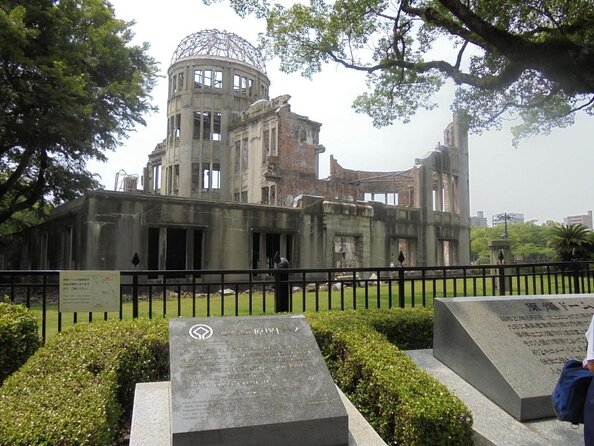
- The tour starts at 07:50 AM from a central location in Osaka and ends at Osaka Station around 9:00 PM.
- The tour includes a visit to Miyajimaguchi, where participants can board a boat to Miyajima Island and explore the Itsukushima Shrine and Treasure Hall.
- Lunch is not included in the tour and you will have the option to enjoy a meal at a local eatery.
- The tour also includes a visit to the Hiroshima Peace Memorial Park and Museum to reflect on the history.
Not for you? Here's a few more great tours and experiences nearby.
- Private Transfer From Osaka Kansai Airport (Kix) to Maizuru Port
- Osaka Kansai Airport (Kix) to Osaka Hotels – Round-Trip Private Transfer
- Private & Custom Osaka-Nara Day Tour by Land Rover Discovery Sport 2018
- Round-Trip Private Transfer From Osaka Kansai Airport to Kobe
Departure Details
The departure details for the 1 Day Hiroshima & Miyajima Tour include starting at 07:50 AM and ending at Osaka Station.
Participants will depart from a central location in Osaka and transfer to Shin-Osaka station to board the bullet train to Hiroshima.
The tour will return to Osaka station around 9:00pm. The end point of the tour is Osaka Station, located at 3-chōme-1-1 Umeda, Kita Ward, Osaka, 530-0001, Japan.
It’s important to note that lunch isn’t included in the tour and infants must sit on laps.
Plus, the tour may be canceled if the minimum number of participants isn’t met. It’s recommended to confirm the tour within 48 hours of booking and to review the cancellation policy, which allows for a full refund if canceled up to 24 hours in advance.
Itinerary Highlights

One of the itinerary highlights includes exploring the Itsukushima Shrine and Treasure Hall. The Itsukushima Shrine is a UNESCO World Heritage Site located on Miyajima Island near Hiroshima. It’s known for its iconic torii gate that appears to float in the water during high tide. Visitors can explore the shrine complex, which includes the main hall, treasure hall, and other buildings. The Treasure Hall houses a collection of precious artifacts and cultural treasures. While lunch isn’t included in the tour, there are plenty of options available on Miyajima Island, ranging from local eateries serving traditional Japanese cuisine to international restaurants. This allows visitors to enjoy a delicious meal while taking in the historical sites and natural beauty of the island.
Additional Information
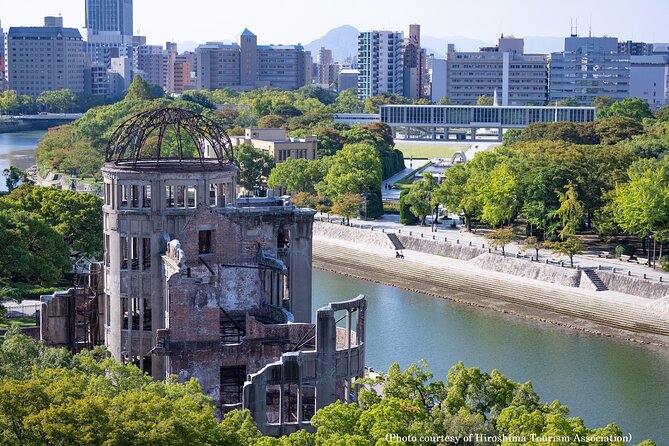
Occasionally, travelers may need to refer to the additional information provided for important details about the tour.
When it comes to the Osaka Departure – 1 Day Hiroshima & Miyajima Tour, there are a few key points to note.
Firstly, lunch options aren’t included in the tour, so you will have the freedom to choose their own dining experience. Whether it’s sampling local cuisine or opting for familiar dishes, there are plenty of eateries to choose from.
Secondly, it’s important to be aware that the tour isn’t wheelchair accessible. This means that individuals with mobility limitations may face challenges in certain areas.
However, the tour does provide a rich cultural and historical experience, allowing participants to delve into the intriguing past of Hiroshima and Miyajima.
Cancellation Policy
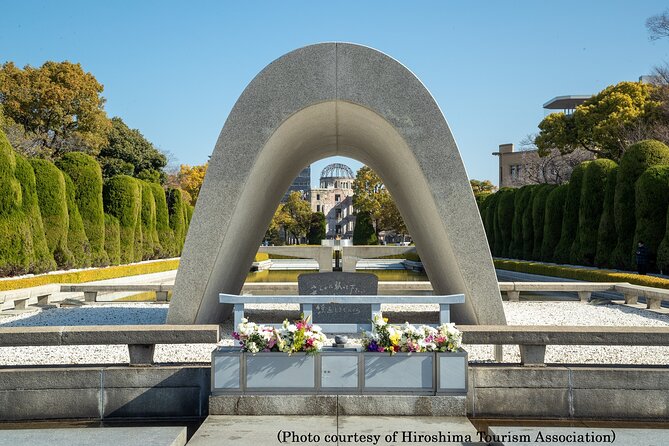
If a participant cancels less than 24 hours before the start time of the Osaka Departure – 1 Day Hiroshima & Miyajima Tour, they’ll not receive a refund. This cancellation policy ensures that participants are committed to the tour and allows for proper planning and organization. It also protects the tour operator from financial loss due to last-minute cancellations.
When discussing the effectiveness of the tour guide, it’s important to consider the reviews from previous participants. Positive reviews mention well-organized tours, brilliant guides, and informative and funny commentary. These guides are praised for their knowledge and ability to provide historical and personal information. On the other hand, negative reviews mention limited explanations, repeated information, and a lack of historical perspective. Some participants felt that the tour guide didn’t add anything that couldn’t be done independently.
The tour guide’s effectiveness can vary based on individual experiences and expectations. It’s important for participants to consider their preferences and what they hope to gain from the tour before making a decision.
Reviews and Praise
The tour guide received both positive reviews and praise for their well-prepared logistics and on-time transportation. The tour participants commended the guide’s performance, highlighting their knowledge, professionalism, and ability to provide informative and engaging commentary throughout the tour. Many praised the guide for their cultural and historical insights, describing the experience as a priceless learning opportunity.
The tour group appreciated the guide’s efficiency in transportation, including the prompt departures and timely transfers to various destinations. The guide’s assistance with navigating the bullet train and ensuring smooth transportation to Miyajima and Hiroshima was also highly regarded.
However, there were a few negative reviews that criticized the tour guide for not adding much value beyond transportation and for limited explanations of the historical context.
Despite this, the majority of participants expressed their satisfaction with the tour guide’s performance and the efficiency of the transportation provided.
Frequently Asked Questions
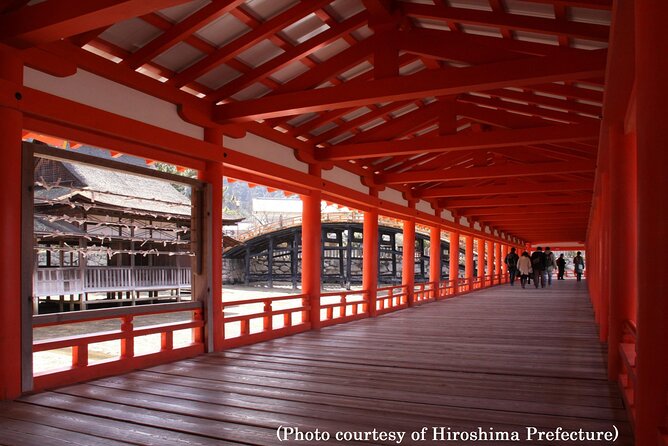
What Is the Average Group Size for the ‘Osaka Departure – 1 Day Hiroshima & Miyajima Tour’?
The average group size for the tour is not specified in the given information. However, it is recommended to check the tour restrictions and contact Viator Help Center for more details.
Can I Bring My Own Lunch or Snacks on the Tour?
Yes, participants can bring their own lunch or snacks on the tour. This allows for flexibility, especially for those with dietary restrictions. It’s a convenient option to cater to individual preferences during the trip.
Are There Any Age Restrictions for the Tour?
There are no age restrictions mentioned in the tour regulations. However, it is important to note that infants must sit on laps during the tour. It is best to confirm with the tour provider for any specific age requirements.
Is There Any Free Time for Shopping or Exploring on the Tour?
Yes, there is free time for shopping or exploring on the tour. Participants will have the opportunity to visit local attractions and explore the area at their own pace, including shopping options.
Can I Bring a Stroller or Wheelchair on the Tour?
Yes, strollers and wheelchairs are not recommended due to restrictions and limited accessibility on the tour. It is advisable to contact the tour operator or check the tour’s official website for more information.
To sum it up, the Osaka Departure – 1 Day Hiroshima & Miyajima Tour offers a captivating and convenient way to explore the cultural and historical riches of Hiroshima and Miyajima Island.
From the bullet train ride to the iconic Itsukushima Shrine, participants are treated to a well-organized itinerary and knowledgeable guides.
Whether you’re a history enthusiast or simply looking to delve into Japan’s rich heritage, this tour promises an unforgettable experience.
Related Posts

Private Airport Transfer Kansai Airport in Kyoto Using Hiace
- December 31, 2023

Private Miyajima Oyster and Sakurao Whisky Distillery Tour

Seasonal Shuttle to Minami-Sado
Trending now.

The Perfect Miyajima Day Trip From Hiroshima (One Day Itinerary)
This page may contain affiliate links which earn us a commission at no extra cost to you to support the site. Thank you!
Planning to take a day trip to Miyajima from Hiroshima? We’ve put together the perfect one day Miyajima itinerary!
Off the coast of Hiroshima Prefecture lies Miyajima, a small island attracting visitors from all across the world.
Its Grand Torii Gate is acknowledged as one of the three most aesthetic views in all of Japan – also known as nihon sankei (日本三景). At sunset, Miyajima’s most famous landmark looks downright fairytale-like, almost as if someone cast a spell on the scenery.
Our guide will provide you with an itinerary for a Miyajima day trip that not only covers Itsukushima Shrine and its floating vermilion gate but all the worthwhile places this beautiful island has to offer.
Miyajima Itinerary Overview & Map
When visiting Hiroshima, taking a day trip to Miyajima is almost essential. This beautiful place makes for the perfect addition to your Japan itinerary .

One Day Miyajima Itinerary
Want to make the most out of a Miyajima day trip from Hiroshima? Here is how to go about it.
1. Travel To Miyajima From Hiroshima
Our Miyajima itinerary starts with a 30-minute train ride from Hiroshima Station . Take the JR Sanyo Line (bound for Iwakuni) to Miyajimaguchi Station . From here, walk around 5 minutes to the nearby ferry terminal.
You don’t need to book your tickets in advance. Crossing over to Miyajima from Miyajimaguchi will only take 10 minutes and the ferries usually operate on a very regular schedule, multiple times an hour.
There are two major companies to choose from – the JR West Miyajima Ferry and the Miyajima Matsudai Kisen . Each of them charges 180 Yen for a one-way ride. If you have the JR Pass , make sure to use the JR West Miyajima Ferry for a free ride.
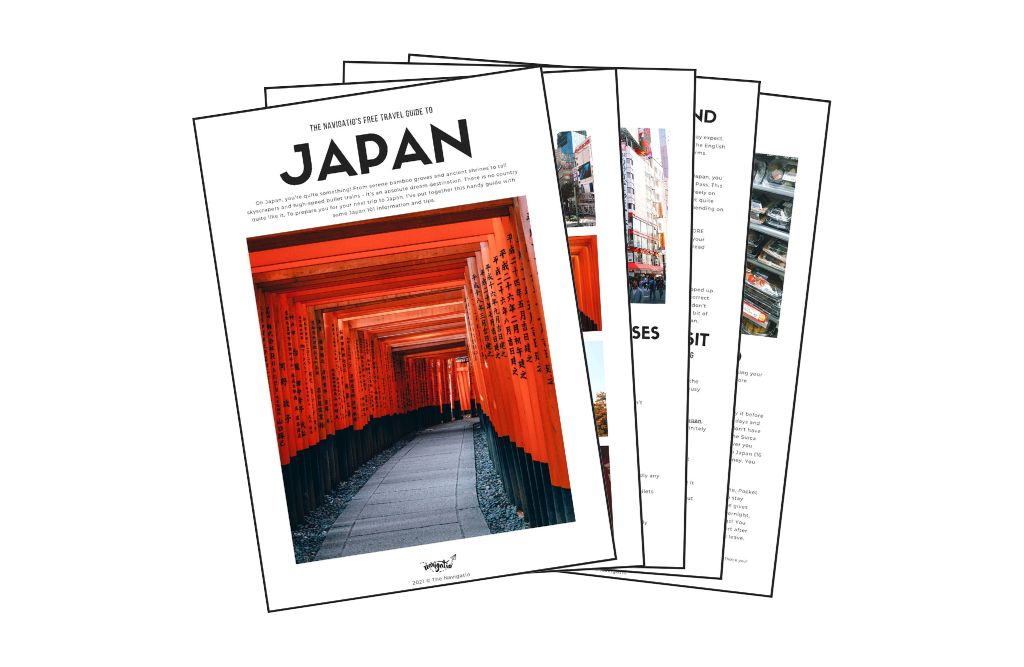
Get Your Free Japan Guide
Subscribe to get inspired! Receive insider tips, special discounts and travel stories. Plus, you’ll get a FREE downloadable Japan Travel Guide for signing up – including everything you need to know before visiting Japan!
You can unsubscribe anytime. For more details, review our Privacy Policy . (We promise not to spam!)
Almost there!
Thank you! Make sure to go to your inbox to confirm your newsletter subscription for your free Japan travel guide.
2. Arrive At Miyajima Pier
Miyajima is overall very mountainous . All the well-known sightseeing spots and shops are located in the upper half of the island, fairly close to the pier. But still, be prepared for a lot of walking throughout the day.
Once you arrive in Miyajima, walk along the shore to reach the area surrounding Itsukushima Shrine. This should take around 10–15 minutes. Soon, you’ll be able to make out the shape of the shrine’s famous vermilion gate in front of you, and dozens of deer.
Just like Nara , Miyajima is well-known for its gentle-eyed furry residents. It even goes by the nickname “ deer island ”. Don’t let them trick you with their charming attempts to steal food from your bags though. They can be pretty cunning if they want to!
3. Ascend The Staircase To Senjōkaku Pavilion
Before entering Itsukushima Shrine, walk up the small hill that will lead you to the Five-Storied Pagoda of Miyajima, and Senjōkaku Pavilion . Senjō (千畳) translates as “ one-thousand tatami mats ”, which is a common unit for measuring the size of a room in Japan.
Senjōkaku Pavilion was originally commissioned by Toyotomi Hideyoshi in 1587 and has never been fully completed after his death. Its unfinishedness is what makes this place oddly charming.
Make sure to take your shoes off before exploring the huge wooden terrace and take a peek at the crystal blue Seto Inland Sea surrounding Miyajima. The view is 100% worth the short hike!
After checking out the area, walk back down to Itsukushima Shrine. It’s finally time to see Miyajima’s most famous landmark up close…

4. Explore Itsukushima Shrine
Itsukushima Shrine (or Itsukushima-jinja) was designated a World Heritage Site by UNESCO in 1996. The shrine itself was reportedly built in 593 during the reign of Empress Suiko. Famous for its red torii gate, it steadily became one of the most beloved places in Japan over the last decades.
Coming down from Senjōkaku Pavilion, you should be directly heading towards the entrance. The admission fee for Itsukushima Shrine and the Treasure Hall is 300 Yen each, the combined ticket costs 500 Yen.
In Itsukushima Shrine, follow the course from the entrance on the east side to the exit on the west side, passing by all the different buildings. On the elevated stage close to the main hall, you’ll have a great view of the Grand Torii Gate.
The Treasure Hall is located right behind the western exit and houses around 4,000 historic and artistic artefacts. When buying the combined ticket, it’s most convenient to visit this place after Itsukushima Shrine.

5. Admire The Grand Torii Gate
The current Grand Torii Gate was built in 1875. Between 2019 and 2022, it underwent extensive restoration and can now be unrestrictedly admired by visitors from all over the world again. It won’t come as a surprise that this is one of the most famous landmarks in Japan .
Miyajima is influenced by strong tides. While the high tide is the most popular time to visit the Grand Torii Gate, the low tide also comes with its advantages. If you happen to visit during low tide at noon, don’t miss out on the chance to walk right up to the gate. Or postpone your stroll to the evening, in the case of high tide.
No matter what, either view is beautiful and you can experience both when spending a whole day on Miyajima. After taking your pictures, it’s time to check out Mt. Misen.

6. Relish The View From Mt. Misen
From Itsukushima Shrine, walk to the Miyajima Ropeway Momijidani Station. This should take around 10–15 minutes. There is a picturesque trail leading through Momijidani Park across the Momiji Bridge and the Momijidani Bridge.
Reaching 535m above sea level, Mt. Misen is the highest peak on Miyajima. By ropeway, you first need to go all the way up to Shishiiwa Station including a transfer at Kayadani Station. From there, follow the path up to Mt. Misen Observatory on foot.
This requires some time and stamina, as the trail is a little steep. Luckily, there are some places to stop by on the way like the Eternal Flame of Reikado Hall . Some visitors prefer to return after going to Shishiiwa Observatory, but for a 360° panoramic view of the Seto Inland Sea, climbing up to Mt. Misen Observatory is necessary.
If you still want to have enough time for some souvenir shopping and street food tasting, make sure to not return too late. You can find detailed information on the fares and operating hours of the ropeway on their official site .

7. Shop In Miyajima Omotesandō Shopping Street
Once you’ve returned to Momijidani Station, follow the path back through Momijidani Park to the liveliest area of Miyajima. On Miyajima Omotesandō Shopping Street , you’ll find shops selling all kinds of handicrafts, souvenirs, and street food.
Not only is this the perfect opportunity to rest for a while in a café or restaurant, but also to taste some of Miyajima’s local specialities.
8. Try Miyajima’s Famous Momiji Manjū
There is one particular speciality you have to try when visiting Miyajima. Momiji Manjū are small pastries shaped like maple leaves, typically filled with red bean paste. But if you keep your eyes open while walking past the stores and souvenir shops in the area, you might discover other fancy flavours.
The Momijido Main Store (紅葉堂本店) on Omotesandō Shopping Street has a nice selection of fruity, sweet and savoury fillings readily available. Aside from the regular Momiji Manjū, they also sell Agemomiji (揚げもみじ), a deep-fried version of Miyajima’s sweet treat that also comes in various flavours.
9. Watch The Sunset At The Grand Torii Gate
Before dusk, head back to the Grand Torii Gate of Itsukushima Shrine. If you haven’t been able to see the area during high tide or vice versa, this is your chance to make up for that.
At the right moment, the sun will peak through the four-pillar construction, dyeing the frothy waves or wet sand beneath the gate in the deepest orange. After sunset, the sky above the surrounding mountains will still be glowing in warm colours for a while. It’s the perfect place to end your Miyajima day trip.

10. Return To Hiroshima Station
With the dark slowly taking over the island, our Miyajima itinerary comes to an end. It’s time to walk back to Miyajima Pier and enjoy the sea breeze one last time before boarding the ferry. From Miyajimaguchi Station, take the JR Sanyo Line to Hiroshima Station. Within a total of 40 minutes, you’ll be back in Hiroshima .
The ferries operate very regularly until around 5PM or 6PM and reduce their frequency shortly thereafter.
How To Get To Miyajima From Hiroshima
Here are the best ways to get to Miyajima from Hiroshima:
1. JR Sanyo Line + JR West Miyajima Ferry / Miyajima Matsudai Kisen
The easiest and cheapest way to get to Miyajima from Hiroshima is by taking the JR Sanyo Line (420 Yen) from Hiroshima Station to Miyajimaguchi Station . The train ride will take you around 30 minutes.
From there, board a ferry that will bring you to Miyajima Pier within 10 minutes. Two major companies are operating between Miyajimaguchi Station and Miyajima Pier – the JR West Miyajima Ferry and the Miyajima Matsudai Kisen (both available at 180 Yen for a one-way ride).
If you’re using the JR Pass , taking the JR Sanyo Line and the JR West Miyajima Ferry will be the most convenient and cost-effective option for you.
2. Ferry From Motoyasu Pier
A noteworthy (although more expensive) method to access Miyajima is by taking a ferry from Motoyasu Pier , located close to the Atomic Bomb Dome. The ferry ride takes about 45 minutes and costs 2,200 Yen one-way or 4,000 Yen for a round-trip.
Choosing this route only makes sense if you’re interested in having some sightseeing included in your cruise or if you intend to see the Peace Memorial Park, the Atomic Bomb Dome, and other close-by sights such as the Hiroshima Museum of Art before going to Miyajima. Tickets for the ferry are available directly at the dock.
Assuming that you have enough time to spend a whole day in Miyajima and will do sightseeing in Hiroshima on another day, taking the train from Hiroshima Station and the ferry from Miyajimaguchi is undeniably the easiest way to access the island.
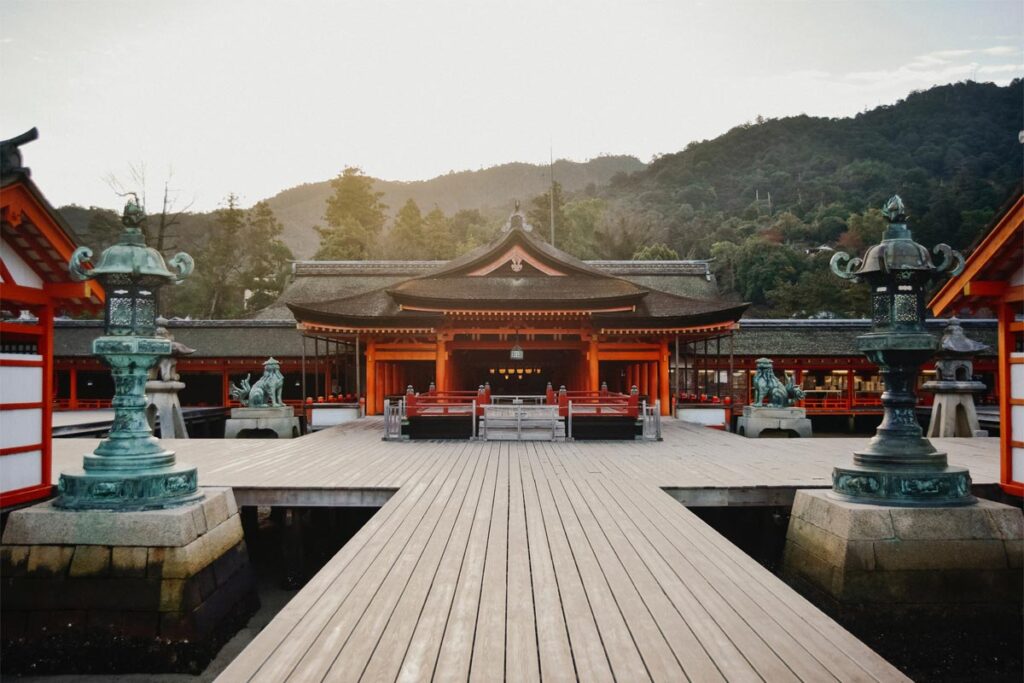
Is Miyajima Worth A Day Trip?
Yes, Miyajima is worth visiting! Thanks to its good access to public transportation, a Miyajima day trip from Hiroshima is very easy to plan and absolutely worth it.
Miyajima is by far one of the most beautiful day trip destinations in Japan. With its eye-catching Grand Torii Gate seemingly floating on the sea, this small island more than deserves to be called one of the three most scenic places in Japan.
A day trip is more than sufficient to visit all the main sights. But if you have a little extra time, staying in a Ryokan for a night and checking out some of the surrounding hiking trails the next day could be a great addition to further enhance your travel experience to Miyajima.
Can You Do Miyajima And Hiroshima In One Day?
Yes and no . Both Miyajima and Hiroshima have a lot to offer, and thoroughly exploring both places takes more than one day. However, we understand that you have to make choices when it comes to putting together a Japan itinerary . If you’re short on time, you can still see the most famous landmarks in both places in one day.
If you’re planning to do this, you can either book a one day Hiroshima and Miyajima guided tour from Osaka , or follow our one-day itinerary for both places below:
Instead of going all the way to Miyajimaguchi Station to board a boat, consider taking a ferry departing from Motoyasu Pier . You can purchase your tickets directly at the terminal on the date – 2,200 Yen for a one-way ticket and 4,000 Yen for a round-trip ticket on the Hiroshima World Heritage Sea Route.
If your starting point in the morning is Hiroshima Station, take a bus to the Peace Memorial Museum first and explore the surrounding Peace Memorial Park afterwards. The ferry dock is within walking distance of the Atomic Bomb Dome . You’ll have enough time to see the whole area before noon and then head over to Miyajima.

The ferry from Motoyasu Pier is considerably more expensive than combining the JR Sanyo Line (420 Yen) from Hiroshima Station and the JR West Miyajima Ferry/ Miyajima Matsudai Kisen (180 Yen) to Miyajima Pier. You can save money by buying only a one-way ticket from Motoyasu Pier to Miyajima and returning to Hiroshima Station by using the regular Miyajima ferries and the JR Sanyo Line in the evening.

The boat trip from Motoyasu Pier will take around 45 minutes. On the way, you can enjoy some sightseeing as the ferry passes by a few important landmarks of the city – a nice asset for those who are lacking time to fully explore Hiroshima.
The tides can affect the operating schedule of the ferry from Motoyasu Pier. Make sure to watch out for unexpected schedule changes on the official website to avoid any kind of unnecessary trouble.
Before going to Miyajima on a tight schedule, you might want to check out the three-hour or half-day sightseeing courses the Miyajima Tourist Association created. Both routes skip on Mt. Misen and its observatory deck but they cover a couple of other stops on the island that are within reach on foot from Miyajima Pier .
On your way back, take the JR West Miyajima Ferry or the Miyajima Matsudai Kisen from Miyajima Pier to Miyajimaguchi Station and ride the JR Sanyo Line until you reach Hiroshima Station.
Conclusion – Miyajima Day Trip
Home to one of the three most scenic views in Japan, Miyajima is widely known for its mesmerising landscapes. And being easily accessible from Hiroshima, a Miyajima day trip makes for an ideal activity for first-timers as well as experienced travellers in Japan.
If you’re considering travelling to Hiroshima and are still looking for a day trip destination or simply have some blank spaces in your Japan itinerary to fill, don’t hesitate to devote some of your time to Miyajima.
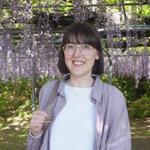
Sabrina holds a bachelor’s degree in Japanese Studies and has spent the past one and a half years studying in Germany, Japan, and Korea as a graduate student in Transnational European and East Asian Studies. In 2018, her journey led her to Kyoto where she experienced Japan’s traditional side for twelve months. Currently living near Tokyo, she enjoys her free time reading novels, trying all things matcha, and exploring the 47 prefectures of her favourite country.
View all posts
Leave a Comment Cancel reply
This site uses Akismet to reduce spam. Learn how your comment data is processed .
Must-Read Articles

50+ Best Things To Do In Japan

Is The Japan Rail Pass Worth it?

The Perfect Three Week Japan Itinerary
Japan Travel Tips Group

The Japan Travel Newsletter
Sign up to get inspired! Receive insider tips, special discounts and more to plan your perfect Japan trip.
You have successfully joined our subscriber list.
japan travel Blog
Tokyo Kyoto Osaka Hiroshima Hakone Kobe Nikko Nara Kyushu All Japan Content
Plan Your Trip
Best Things To Do Japan Rail Pass 2 Week Itinerary 3 Week Itinerary Accommodation Japanese Phrases
About The Navigatio Work With Us
- Destinations
How to Visit HIROSHIMA and MIYAJIMA in ONE DAY (3 Easy Steps Guide)
This site uses affiliate links, meaning that if you make a purchase through our links, we may earn an affiliate commission.
Hiroshima and Miyajima are both iconic destinations, steeped in ancient history as well as recent history, plus both places are filled with delicious food options.
I often get asked if it is possible to do Hiroshima and Miyajima in one day. The answer is YES! However, some advance planning is necessary.
So, here is your step-by-step guide to how to visit Hiroshima and Miyajima in one day.
Check Out These Helpful Posts About Hiroshima:
10 Amazing Things You Can’t Miss on Your First Visit to Hiroshima
Perfect Day Trip to Miyajima from Kyoto, Osaka, or Hiroshima
Perfect One Day in Hiroshima (5 Things You Can’t Miss+Useful Tips)
Hiroshima Peace Memorial Park Self-Guided Walking Tour (8 Easy Steps)
You Might Also Like:
Amazing 3 DAYS in TOKYO (Thrilling Itinerary with 21 Stops)
Ultimate 16-DAY JAPAN ITINERARY for Marvelous Culture, History, and Nature
- 1. How to Get to Hiroshima from Kyoto or Osaka
- 2. How to Get to Miyajima from Hiroshima
- 3. What to Do in Hiroshima (3 Places You Need to Visit)
- 3.1. Atomic Bomb Dome
- 3.2. Hiroshima Peace Memorial Park
- 3.3. Hiroshima Peace Memorial Museum
- 4. What to Do in Miyajima (3 Places You Need to Visit)
- 4.1. Miyajima Island Floating Torii
- 4.2. Itsukushima Shrine
- 4.3. The Ropeway
- 5. Intrepid Scout's Tips for How to Visit Hiroshima and Miyajima in One Day
Before we dive into how to visit Hiroshima and Miyajima in one day , my recommendation is to start your day in Hiroshima and then continue to Miyajima .
It makes more sense logistically to do it that way. You will be more efficient and save time during the day and you will be able to accomplish more!
How to Get to Hiroshima from Kyoto or Osaka
- How to Get to Hiroshima from Kyoto
Kyoto Station and Hiroshima Station are connected by the Tokaido and Sanyo Shinkansen lines. Both lines will take you directly from Kyoto to Hiroshima.
The journey will take about 1 hour and 40 minutes. You can use your JR Pass . In addition, The Nozomi Shinkansen trains only take 1 hour 15 minutes but are not covered by the pass.
- How to Get to Hiroshima from Osaka
Shin-Osaka Station and Hiroshima Station are connected by a bullet train – Sanyo Shinkansen Line. Journey times vary according to the model of the train.
The faster models like the Mizuho and the Nozomi take just 1 hour and 25 minutes, however, they are not covered by the JR Pass.
The fastest train covered by the JR Pass is the Sakura train which takes 1 hour 32 minutes.
- How to Get to Miyajima from Hiroshima
Trains from Hiroshima Station depart every 15 minutes for Miyajima. You are going to exit the train once you reach Miyajimaguchi Station .
It is about a 30-minute ride from Hiroshima to Miyajimaguchi Station. Once you arrive at Miyajimaguchi Station, follow the signs for the Miyajima Island ferry .
The ferry is no more than a 10-minute walk from the Miyajimaguchi Station. Both, the train and the ferry are covered by the JR Pass .
What to Do in Hiroshima (3 Places You Need to Visit)
There is a lot to do in Hiroshima and you can spend at least 2 days exploring this fascinating place. If you have more time for Hiroshima then make sure not to miss these helpful posts:
However, if you only have a few hours to spend in Hiroshima then here are my 3 top places that you need to put on your list :
Atomic Bomb Dome
Atomic Bomb Dome should be one of the first things to do in Hiroshima. It is an iconic symbol of the “peace city” of Hiroshima. Atomic
- Bomb Dome is also called A-Bomb Dome, Genbaku Dome, or the Hiroshima Peace Memorial. It is part of the Hiroshima Peace Memorial Park.
- Hiroshima Peace Memorial Park serves as a memorial to people killed in the atomic bombing of Hiroshima on August 6th, 1945.
- Originally, Atomic Bomb Dome was the Hiroshima Prefectural Industrial Promotion Hall. It housed national and municipal governmental offices.
- The building was located just 160 meters from the epicenter of the blast . Amazingly, it was one of the few structures in the area to remain upright after the explosion.
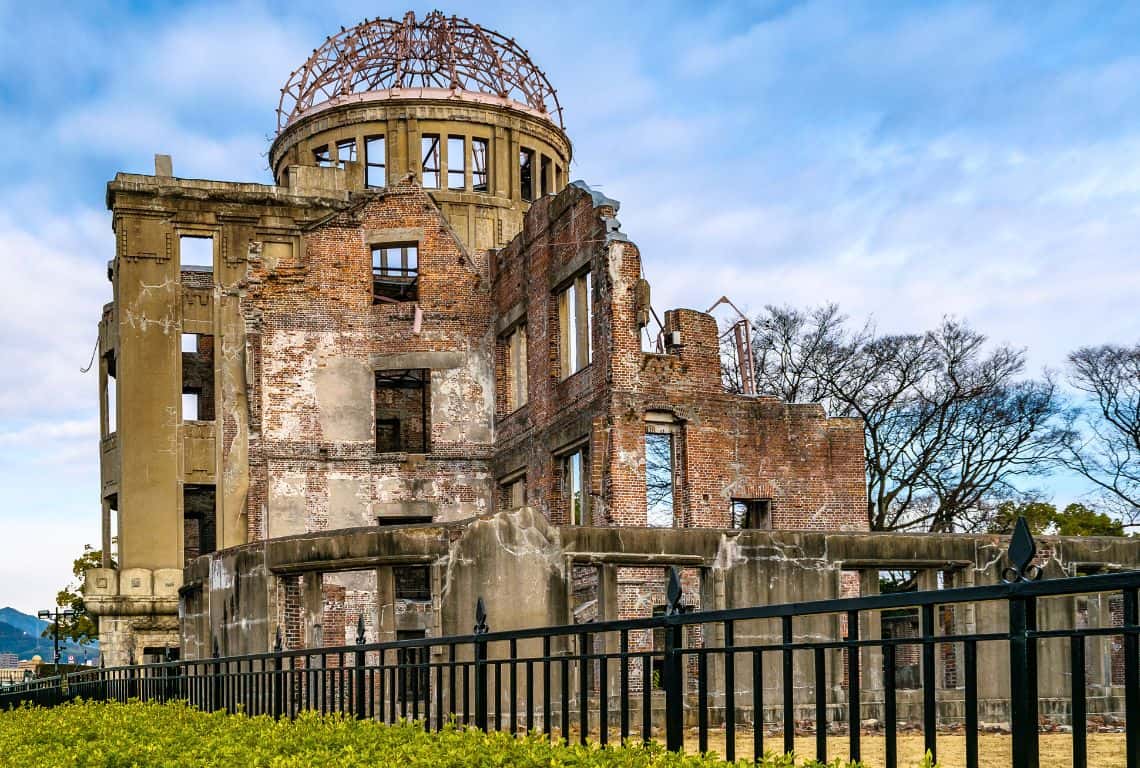
Atomic Bomb Dome / How to Visit Hiroshima and Miyajima in One Day
Hiroshima Peace Memorial Park
Hiroshima Peace Memorial Park was designed by Japanese architect Kenzo Tange. It opened to the public in 1954. The park has a total area of 122,000 square meters and houses a museum, as well as numerous memorials and monuments commemorating the people who perished during the atomic bombing of Hiroshima on August 6th, 1945.
Here are a couple of memorials and monuments that you should stop by:
- Children’s Peace Monument
Children’s Peace Monument is a tribute to Sadako Sasaki and all the children who perished due to the atomic explosion.
Sadako was exposed to the A-bomb at the age of two. Yet, she grew into a strong and healthy girl. However, nine years after exposure to the atomic bomb radiation, she developed leukemia.
Based on a traditional Japanese belief, Sadako thought that if she folded 1,000 origami cranes she would recover. But, after an eight-month battle with the disease, she passed away.
Cenotaph, also known as the Memorial Monument for Hiroshima for the A-bomb Victims is located in the center of the park. It consists of a stone coffer beneath an arch. Within the coffer is a record of the names of victims of the atomic bombing.
Cenotaph is inscribed with the phrase: “Let all the souls here rest in peace for we shall not repeat the evil.”
If you are planning to spend a few more hours in Hiroshima Peace Memorial Park or want to learn more about the events leading to the bombing of Hiroshima then read Hiroshima Peace Memorial Park Self-Guided Walking Tour (in 8 Easy Steps) .
Cenotaph for the A-Bomb Victims / How to Visit Hiroshima and Miyajima in One Day
Hiroshima Peace Memorial Museum
Hiroshima Peace Memorial Museum was built by the city of Hiroshima and it was opened to the public in 1950.
The museum collects materials that convey the horror of Hiroshima’s atomic bombing. It displays artifacts, photographs, and paintings that show Hiroshima before and after the bombing.
It demonstrates the present and current status of the nuclear age.
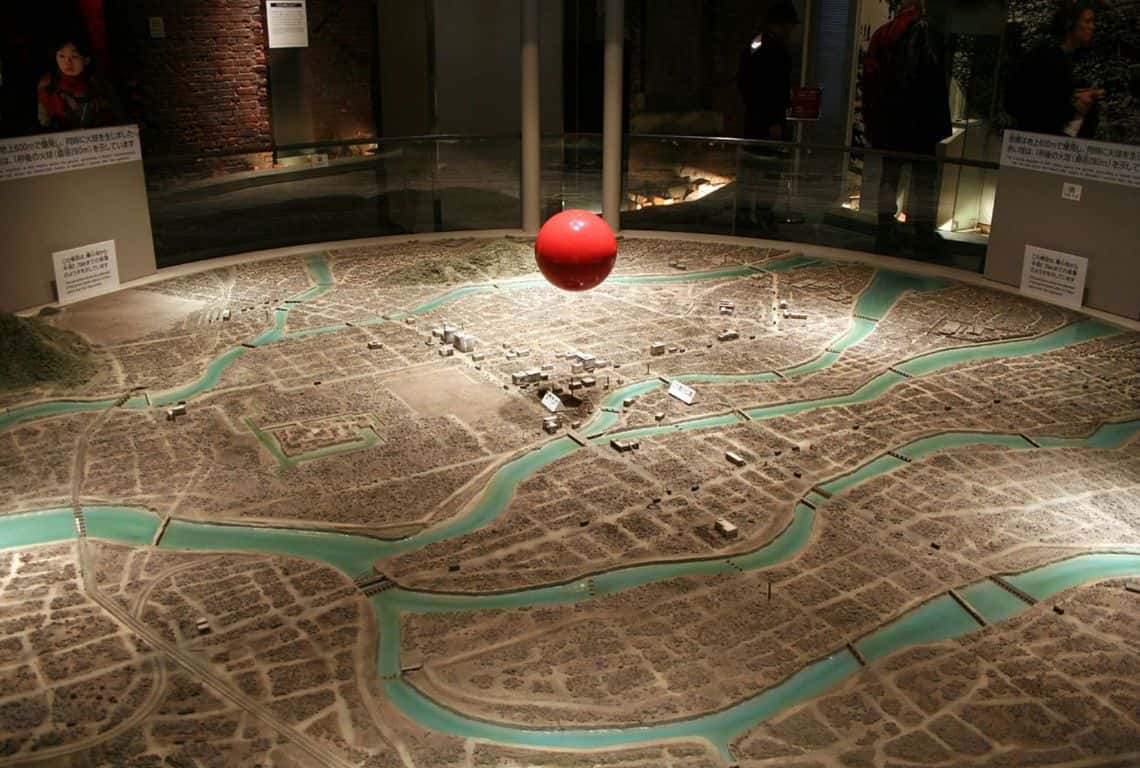
Image Credit: Derek Springer via Wikimedia Commons / How to Visit Hiroshima and Miyajima in One Day
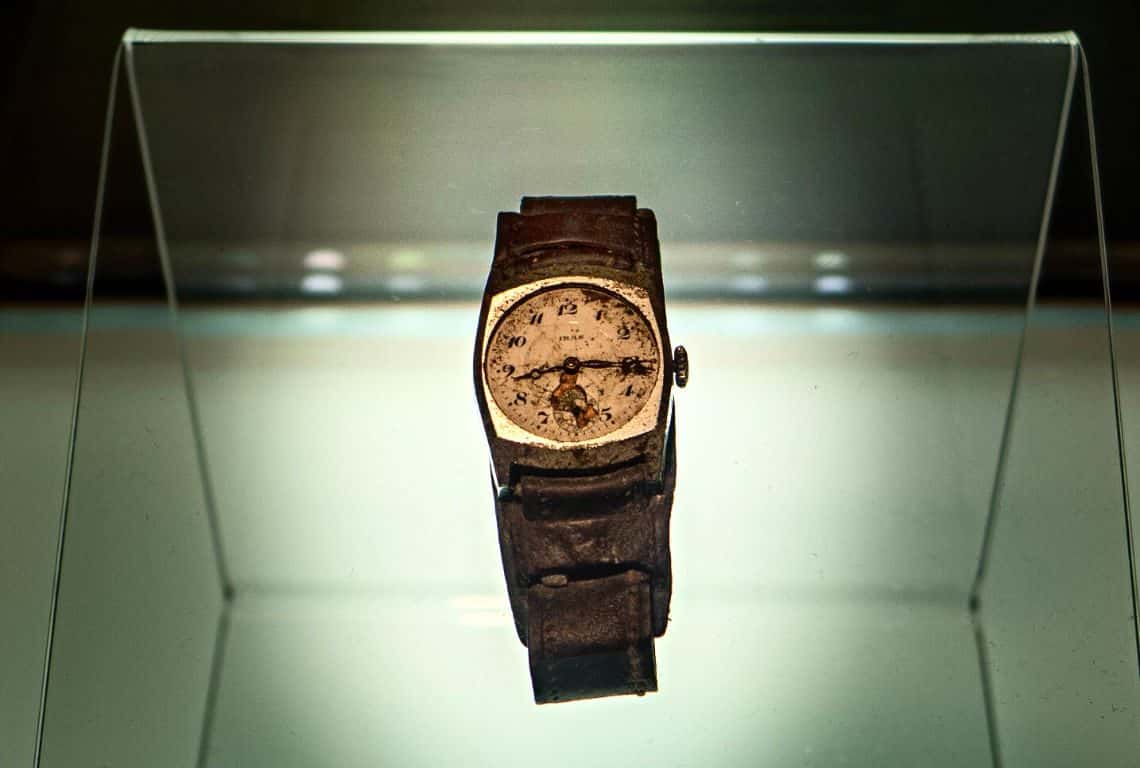
Hiroshima Peace Memorial Museum / How to Visit Hiroshima and Miyajima in One Day
What to Do in Miyajima (3 Places You Need to Visit)
I love Miyajima Island and going to Miyajima is one of my favorite day trips from Hiroshima .
Needless to say, you can easily spend a day exploring the island. In addition, consider spending a least one night on the island. Make sure to read Day Trip to Miyajima from Kyoto, Osaka, or Hiroshima .
Here are my top 3 places you need to visit on Miyajima Island:
Miyajima Island Floating Torii
The number one attraction as well as the symbol of Miyajima Island is a Giant Torii (gate). During the high tide , it appears as if the torii is floating out in the sea.
If you are visiting the island during the low tide , you can walk up all the way to the torii and really get the feel of how enormous this structure is.
Interestingly enough, unlike the traditional torii, which consist of two pillars, the Miyajima Island Giant Torii has additional four supporting pillars. All in all, it weighs about 60 tons and stands almost 17 meters high.
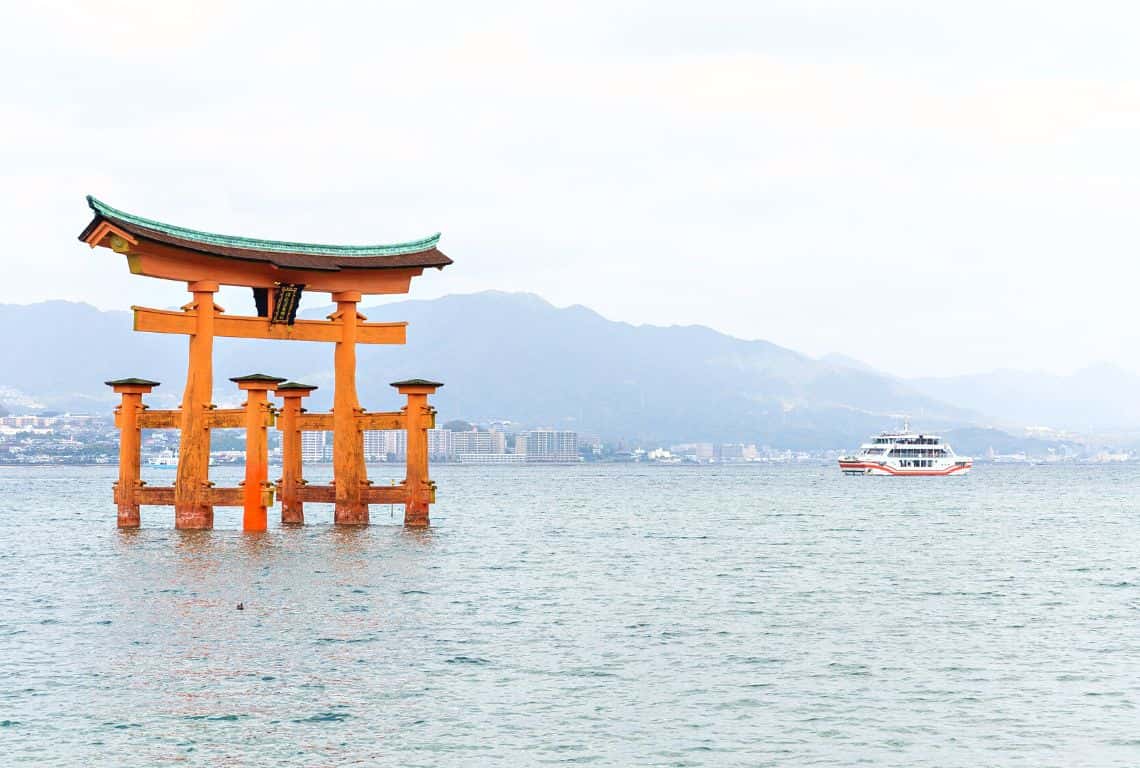
Miyajima Island Floating Giant Torii / How to Visit Hiroshima and Miyajima in One Day
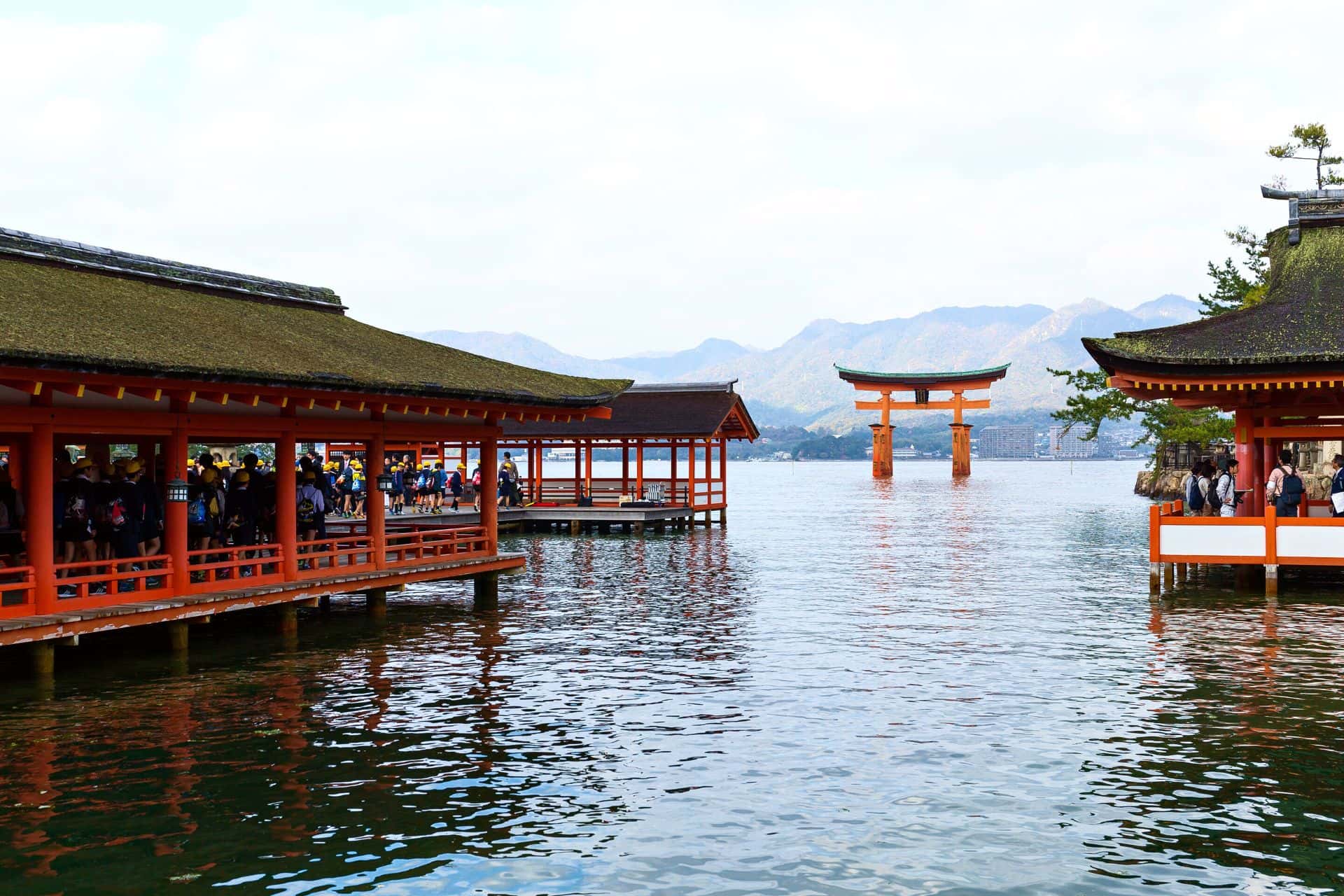
Itsukushima Shrine
Next, head on to Itsukushima Shrine .
The shrine was built in 593 and became an important place of worship in about 1168. In 1996 the World Heritage Committee officially inscribed Itsukushima Shinto Shrine as a World Cultural Heritage.
Itsukushima Shrine is well known for its unique construction. It consists of four main areas:
- the Holy Hall where the gods live (Heiden)
- the inner part where only the priests enter (Haiden)
- the external area for worship (Haraiden)
- the noh theater stage
All the sections are connected by numerous boardwalks and supported by pillars above the sea. During the high tide, the shrine looks as if it is floating in the Seto Sea .
Interestingly enough, the reason why the shrine was built out in the sea was that the island was originally thought to be too sacred for commoners to set foot upon.
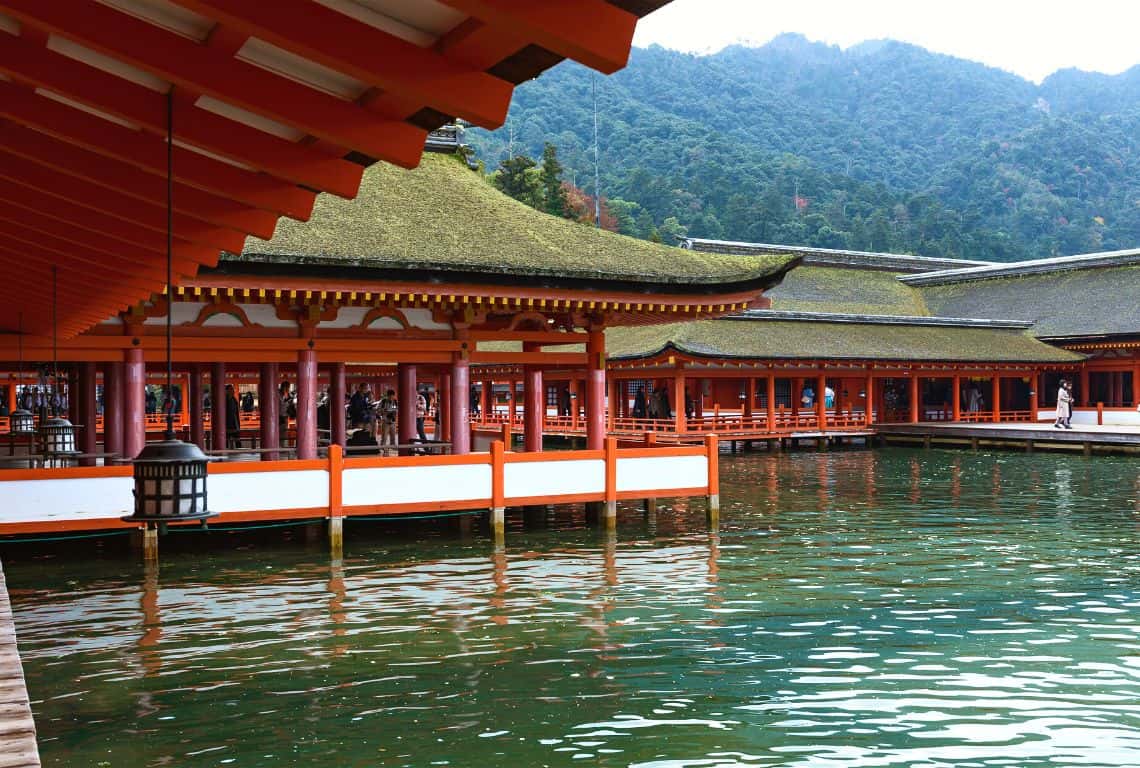
Itsukushima Shrine / How to Visit Hiroshima and Miyajima in One Day
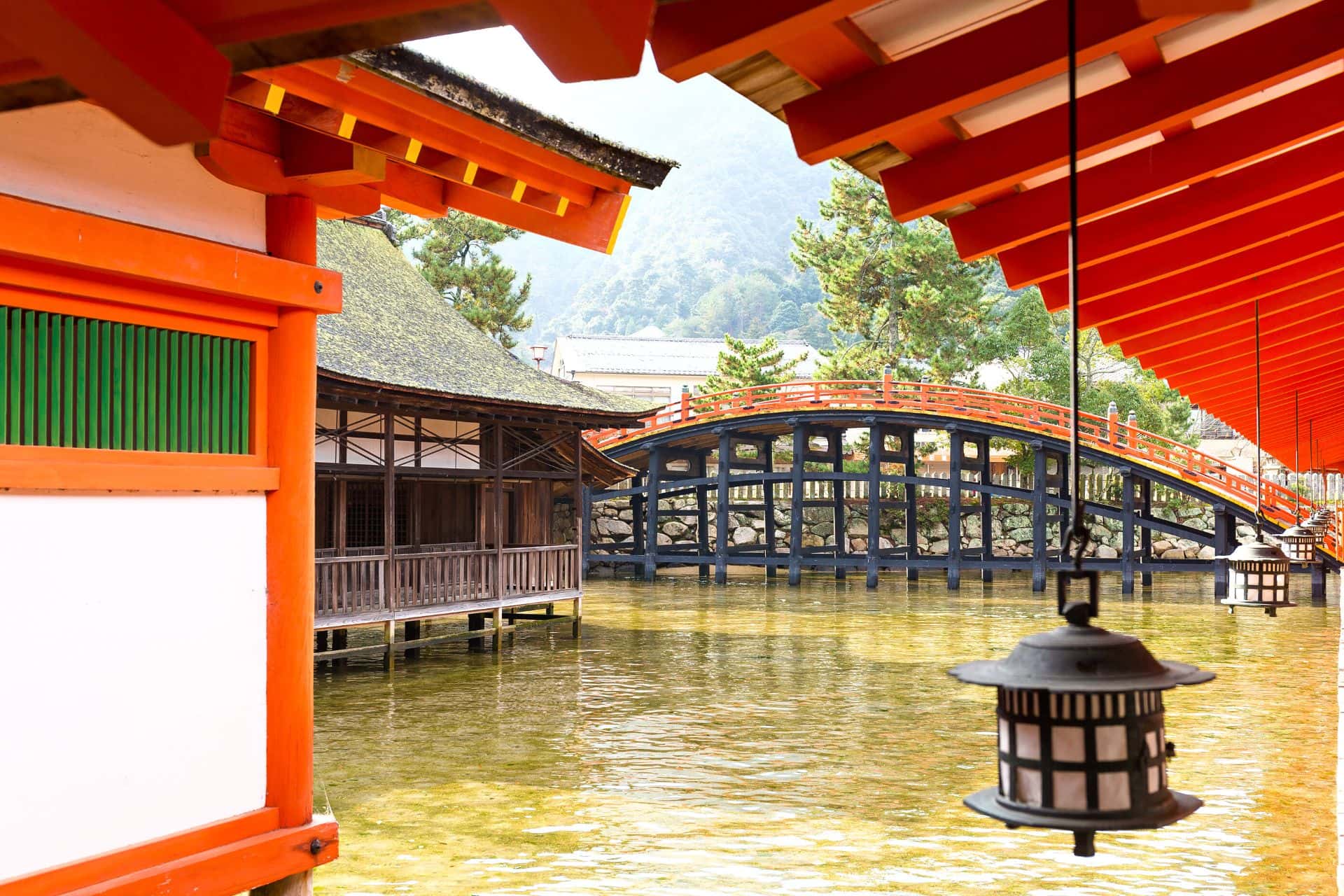
The Ropeway
Next, take the ropeway to catch the magnificent views of the island.
- The ropeway leaves from Momijidani Station . You can take a bus or you can walk to the station. My recommendation is to walk to Momijidani Station. It is no more than a 10-minute hike up a slight incline. Simply, take the path leading from Itsukushima Shrine to Momijidani Park.
- Momijidani Park is a hang-out place for the famous Miyajima Island deer. They will be happy to see you and eager to find out if you have any treats. In addition, Momijidani Park is one of the most famous maple leaves parks in Japan. It is an absolute must-do if you are planning your Miyajima Island day trip in the fall.
- The ropeway goes from Momijidani Station to Kayadani Station . Once you reach Kayadani Station, you will take a second ropeway to your final destination which is Shishiwa Station.
- The Shishiwa Station is 430 meters above sea level. The views of the Seto Sea from the station are breathtaking.
- Tickets for the ropeway are available for purchase at several locations on the island. You can purchase a one-way ticket or a round-way ticket. It all depends on how much time you have to explore the island.
- It is important that you check if the ropeway is operating . The service could be suspended due to adverse weather. You can check prices, hours, and operation conditions here .
The View of Seto Sea from Mount Misen / How to Visit Hiroshima and Miyajima in One Day
Intrepid Scout's Tips for How to Visit Hiroshima and Miyajima in One Day
The visit to Hiroshima and Miyajima would not be complete without trying some local delicacies. Here are some of my favorite things to try:
- Local Delicacies in Hiroshima
While in Hiroshima, you need to try okonomiyaki . It is basically a pancake topped with cabbage, bacon, noodles, egg, and sauces.
How is Okonomiyaki made? Here is my take on it, as I watched it being made:
First, the batter made of flour is poured on an iron griddle. It is spread out in a circular motion to form a thin crepe-like pancake.
Next, a heap of sliced cabbage is placed on the batter, then thin-sliced pork . Consequently, it is cooked for a bit and then turned over with a big spatula and cooked for a little more.
In the meantime, the noodles are fried on the side, and once done they are put on top. Finally, an egg is cracked onto the griddle and spread out in the same circular size, and eventually put on the very top.
In due time, the special sauce is applied on the top as well as some mayonnaise, and aonori (dried seaweed).
- Local Delicacies in Miyajima
Miyajima is a must-see place for oyster lovers . You will find booths selling fresh or grilled oysters all along Omotesando Shopping Arcade. My recommendation is to try some grilled oysters with butter and soy sauce.
Another one of my favorites is Momiji Manju . It is a small pastry in the shape of a maple leaf. Traditionally, it is filled with sweet red azuki bean paste.
Now, It Is Your Turn, I Would Like to Hear Back from You!
Are you planning your trip to Hiroshima and Miyajima?
Please let me know! Drop me a quick comment right below!
Click on any of the images below to get inspired and to help you with the planning process for your trip to Hiroshima and Miyajima!
More Information About Japan:
Perfect ONE DAY in KANAZAWA – 7 Things to Do (BEST TRIP from Tokyo, Kyoto, or Osaka)
14 Amazing Things to Do in Arashiyama (Map+Useful Tips)
What to See at Nijo Castle in Kyoto (10 Top Things to Know)
Stunning Golden Pavilion in Kyoto (How to Visit and What to See)
Amazing Fushimi Inari Taisha in Kyoto (8 Things to Know Before You Visit)
First Visit to Kyoto – How to Visit and What to See (11 Things You Can’t Miss)
2 Days in Kyoto: The Perfect Kyoto Itinerary
Read All the Posts About Japan in:
Japan Travel Guide
Did You Find This Post Useful?
Why not save how to visit hiroshima and miyajima in one day to your pinterest board.
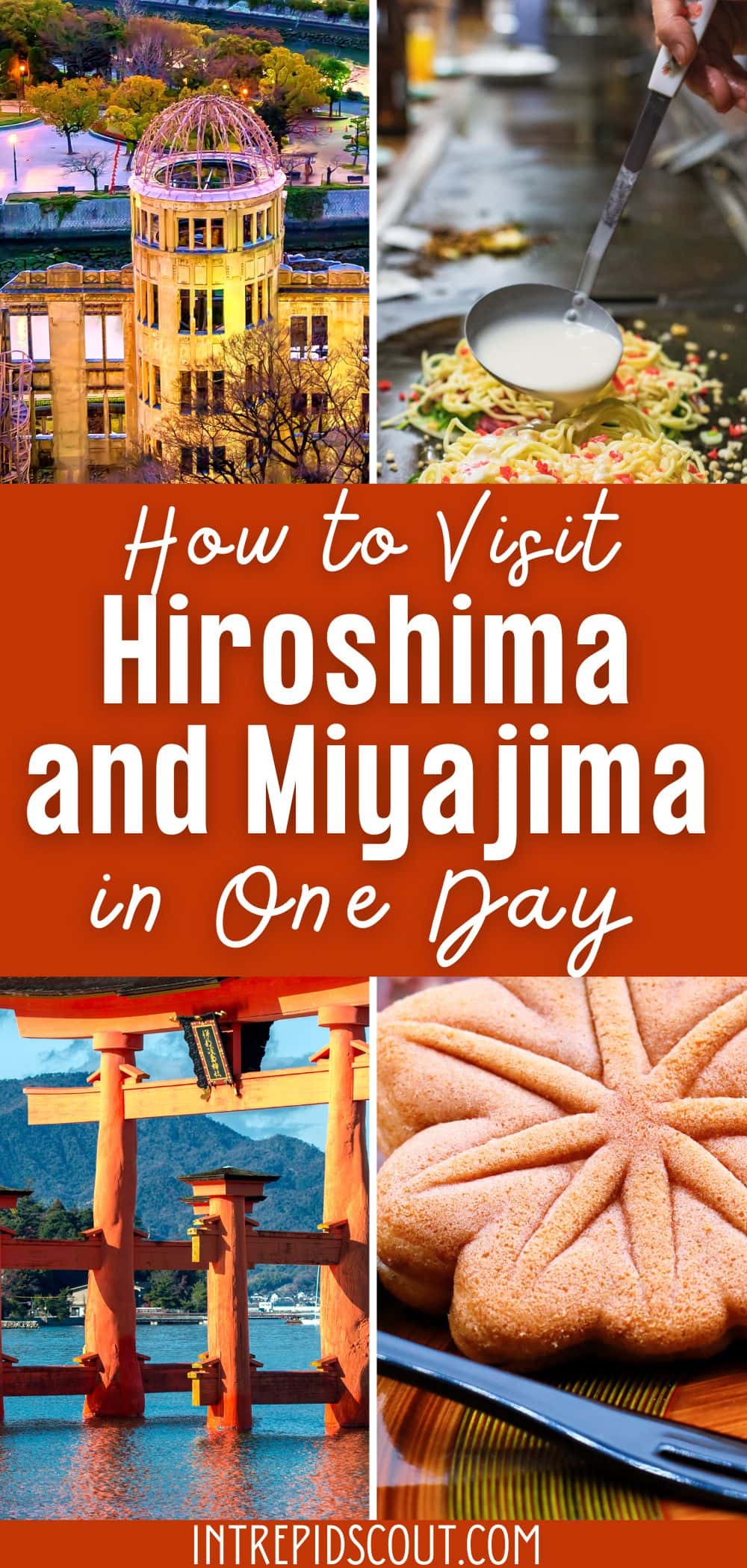
- alert('URL copied to clipboard.')).catch(err => console.error('Unable to copy to clipboard.', err))">
Share via Email
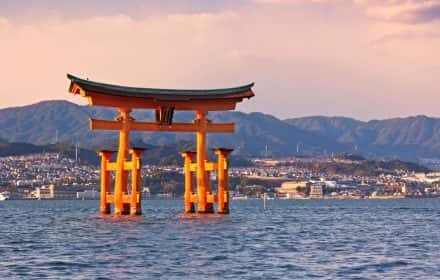
Perfect DAY TRIP to MIYAJIMA from Kyoto, Osaka, or Hiroshima (9 Things to Do)
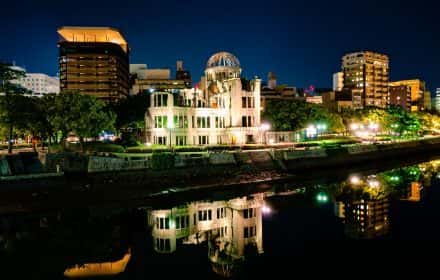
THINGS to DO in HIROSHIMA (10 Amazing Things to Do on Your First Visit)
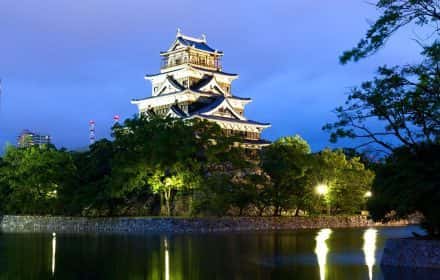
Perfect ONE DAY in HIROSHIMA (5 Things You Can't Miss+Useful Tips)
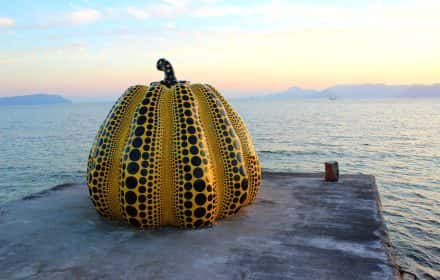
5 Fun and Easy DAY TRIPS from HIROSHIMA (How to Get There+Things to Do+Where to Stay)
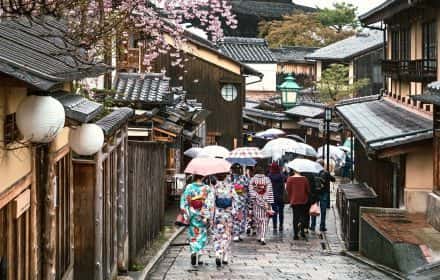
8 THINGS You Can't Miss - Perfect 2 DAYS in KYOTO
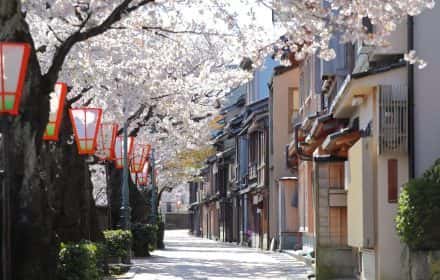
Perfect ONE DAY in KANAZAWA - 7 Things to Do (BEST TRIP from Tokyo, Kyoto, or Osaka)
@intrepid.scout
Leave an answer Cancel reply
Your email address will not be published. Required fields are marked *
The company processes your data to facilitate the publication and management of comments. You can exercise your rights of access, rectification, deletion and objection, among others, according to our Privacy policy .

Hiroshima and Miyajima 1 Day Walking Tour
Step into the past and explore the captivating Hiroshima and Miyajima 1 Day Walking Tour. This immersive experience offers an enchanting journey through time, allowing participants to uncover the hidden gems of these iconic Japanese cities.
Led by knowledgeable guides, this tour takes visitors on a fascinating exploration of Hiroshima’s tragic history during World War II and the resilience of its people. From the picturesque streets of Hiroshima to the breathtaking views of Miyajima Island, travelers will be immersed in the rich culture and natural beauty of Japan.
With a non-refundable policy in place, adventurers are encouraged to plan ahead and ensure they meet the minimum traveler requirement.
Discover the history and beauty of Japan on the remarkable Hiroshima and Miyajima 1 Day Walking Tour.
Quick Takeaways
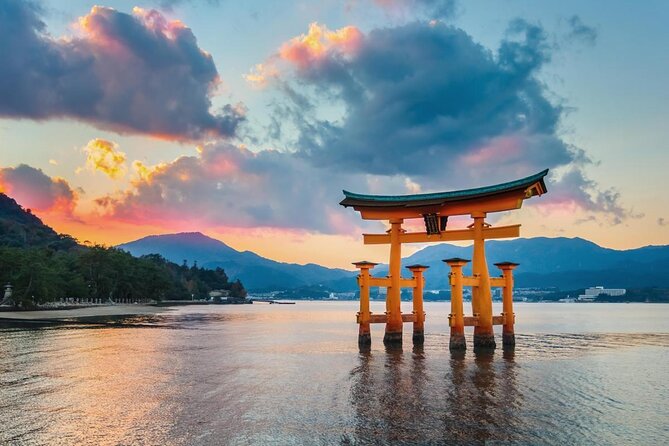
- Visit the Peace Memorial Park
- Explore the iconic Itsukushima Shrine
- Learn about the historical and cultural significance of these landmarks
- Guided tour with knowledgeable guides
Tour Highlights
The tour highlights of the Hiroshima and Miyajima 1 Day Walking Tour include a visit to the Peace Memorial Park and the iconic Itsukushima Shrine. This tour offers an opportunity to explore these significant historical and cultural landmarks in the company of a knowledgeable guide.
When planning for this tour, it’s important to consider what to pack. Comfortable walking shoes, a hat, sunscreen, and a reusable water bottle are recommended. It’s also advisable to bring a camera to capture the beautiful sights along the way.
In terms of the best time to visit, spring and autumn are ideal seasons as the weather is pleasant and the cherry blossoms or fall foliage add an enchanting touch to the landscapes.
The tour provides a unique and insightful experience for those seeking a deeper understanding of Hiroshima’s history and the natural beauty of Miyajima Island.
Itinerary Overview
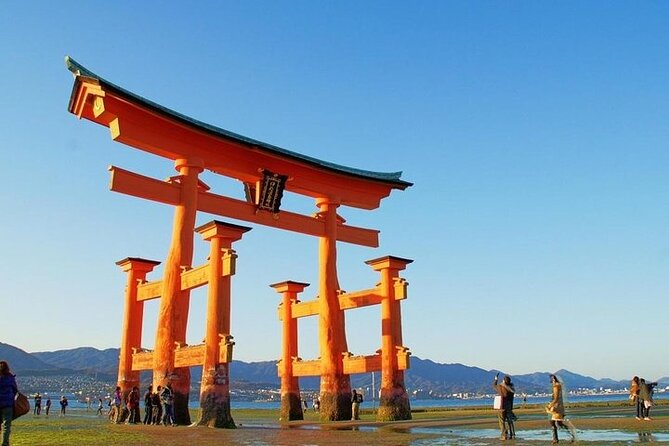
During the Hiroshima and Miyajima 1 Day Walking Tour, you will embark on a comprehensive and engaging itinerary that explores the key attractions of both cities. This tour is designed to offer freedom to the participants, allowing them to explore the destinations at their own pace.
The best time to visit Hiroshima and Miyajima is during the spring and autumn seasons when the weather is pleasant and the cherry blossoms or fall foliage are in full bloom.
As part of the tour, participants must try the local delicacies in Hiroshima and Miyajima. In Hiroshima, the must-try delicacy is the Hiroshima-style Okonomiyaki, a savory pancake layered with noodles, cabbage, and various toppings.
In Miyajima, the local specialty is Momiji Manju, a sweet, maple-leaf-shaped cake filled with different flavors such as red bean paste or custard.
Key Attractions
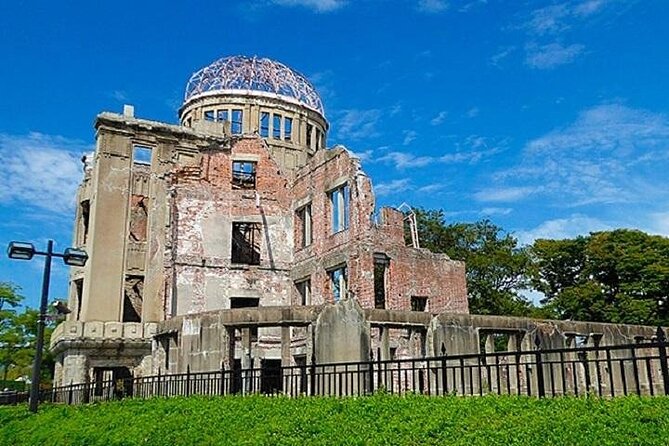
Participants on the Hiroshima and Miyajima 1 Day Walking Tour can explore the top sights and must-see landmarks in both cities within a day.
In Hiroshima, one of the key attractions is the Peace Memorial Park, which commemorates the victims of the atomic bomb and serves as a symbol of peace. Visitors can also visit the Hiroshima Peace Memorial Museum to learn about the devastating impact of the bomb.
Another must-see landmark is the Itsukushima Shrine on Miyajima Island. Known for its iconic floating torii gate, this Shinto shrine is a UNESCO World Heritage site that offers breathtaking views.
Participants on the tour will have the opportunity to experience the rich history and cultural significance of these attractions, making for a memorable day of exploration.
Insider Tips
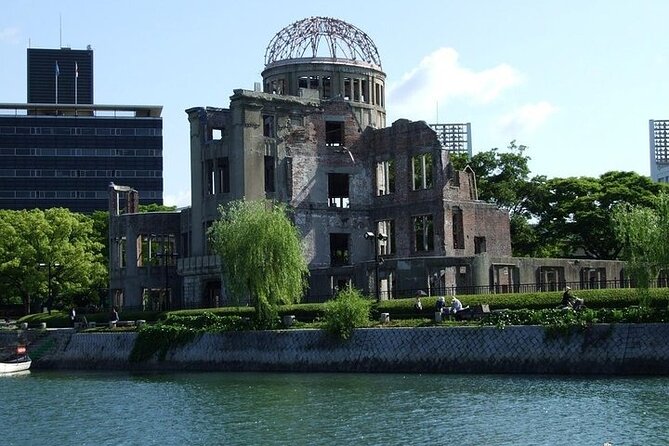
For an enhanced experience on the Hiroshima and Miyajima 1 Day Walking Tour, consider these insider tips.
To truly learn about the local culture, make sure to try the delicious local cuisine. Hiroshima is known for its mouthwatering okonomiyaki, a savory pancake filled with various ingredients. Don’t miss the opportunity to try this iconic dish.
Plus, take advantage of the cultural experiences available on the tour. Visit the Hiroshima Peace Memorial Museum to learn about the city’s history and the impact of the atomic bomb. Explore the stunning Itsukushima Shrine on Miyajima Island, a UNESCO World Heritage site. Be sure to catch the famous Torii gate during high tide for a truly breathtaking sight.
Tour Inclusions and Exclusions
The tour includes a guided walking tour of Hiroshima and Miyajima, providing participants with a comprehensive exploration of these historical and cultural sites. The tour will be led by an experienced guide who’ll share insightful information about the history and significance of each location.
Participants will have the opportunity to visit iconic landmarks such as the Hiroshima Peace Memorial Park, the Atomic Bomb Dome, and the Itsukushima Shrine on Miyajima Island. The tour also includes transportation between the two locations, ensuring a seamless and convenient experience.
However, it’s important to note that certain items aren’t included in the tour. Meals, drinks, and personal expenses aren’t covered, so participants should budget accordingly. Plus, any additional activities or entrance fees outside of the designated tour itinerary will be at the expense of the participants.
Common questions
Are meals included in the hiroshima and miyajima 1 day walking tour.
Meals are included in the Hiroshima and Miyajima 1 Day Walking Tour. Vegetarian options are available. The tour offers a chance to explore the local cuisine while experiencing the rich cultural heritage of these two iconic Japanese destinations.
Can Children Participate in the Tour?
Children can participate in the tour, but there may be appropriate age restrictions for certain activities. It is recommended to check with the tour operator for specific details on children’s activities and any restrictions that may apply.
Is Transportation Included in the Tour?
Transportation is included in the tour. It is one of the tour inclusions, ensuring convenience and ease of travel for participants. From pick-up to drop-off, transportation is provided throughout the day.
Are There Any Age Restrictions for the Tour?
There are no age restrictions for the tour. Meals are not included in the tour package. Participants are responsible for their own meals during the tour.
Is There a Dress Code for the Tour?
There is no specific dress code mentioned for the Hiroshima and Miyajima 1 Day Walking Tour. However, it is recommended to wear comfortable walking shoes and dress appropriately for the weather conditions.
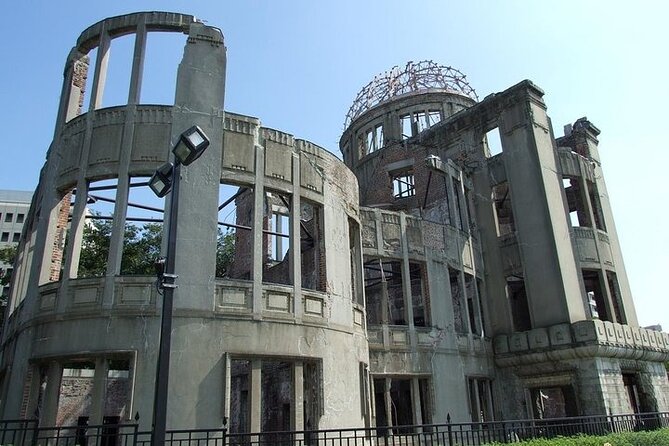
To sum it up, the Hiroshima and Miyajima 1 Day Walking Tour offers a captivating and immersive experience for travelers to explore the history and beauty of Japan. Led by knowledgeable guides, participants can visit significant landmarks in Hiroshima and learn about the tragic events of World War II.
The tour also includes a visit to the stunning Miyajima Island and its famous Itsukushima Shrine. With picturesque streets and breathtaking views, this tour promises to be an unforgettable journey of discovery and appreciation for the resilience of the Japanese people.
Tokyo Trip Checklist
Similar posts.

Private Transfer From Osaka Hotels to Osaka Cruise Port
When it comes to traveling from Osaka hotels to the Osaka Cruise Port, there’s a convenient and flexible option that many may not know about….
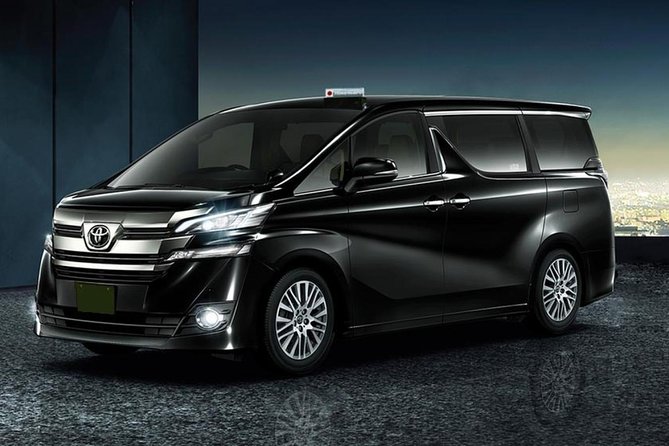
Shared Arrival Transfer : Kansai International Airport to Kyoto City
Travelers seeking a hassle-free and reliable mode of transportation from Kansai International Airport to Kyoto City can benefit from the convenience of a shared arrival…
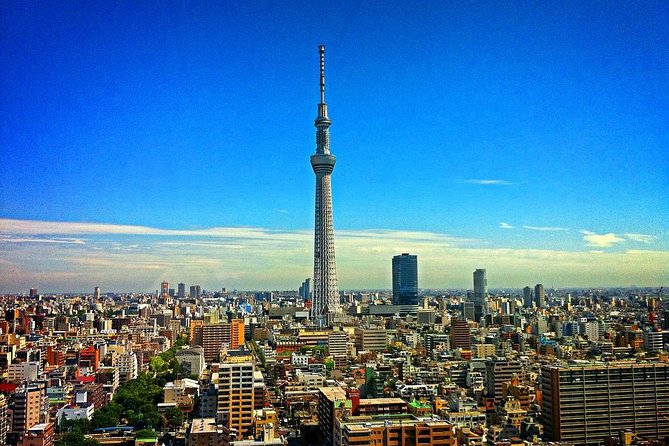
Private Departure Transfer : Central Tokyo City to Haneda Airport
A private departure transfer from central Tokyo City to Haneda Airport offers travelers the freedom and convenience they desire. This exclusive service ensures a stress-free…

Tokyo Water Taxi Bayzone Tour
For those seeking an adrenaline-pumping adventure that involves sitting in a boat and cruising along Tokyo’s picturesque waterfront, the Tokyo Water Taxi Bayzone Tour might…

Tokyo Local Private Tour
Amidst the bustling streets of Tokyo, where neon lights illuminate the night sky and the aroma of street food lingers in the air, lies a…
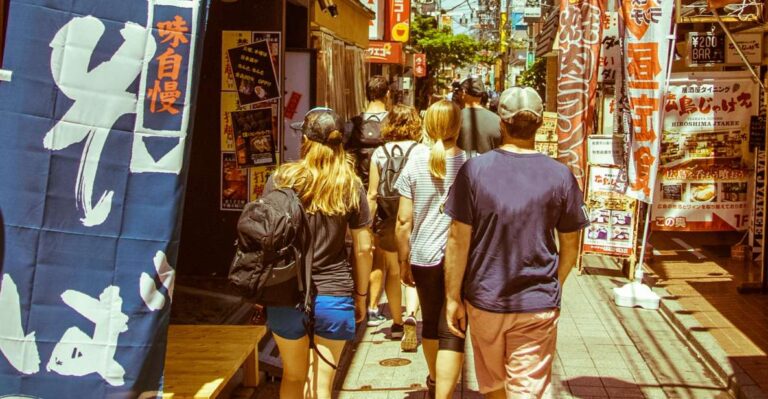
Tokyo: West-Side Walking & Street Food Tour
Tokyo: West-Side Walking & Street Food Tour is a captivating experience that takes participants on a flavorful journey through the vibrant neighborhoods of West Tokyo….
Hiroshima & Miyajima Tour By Bullet Train from Kyoto

Availability
- Important Details
Our Hiroshima & Miyajima Tour By Bullet Train from Kyoto will whisk you away on a magical adventure and show you all of Hiroshima’s highlights. Depart from Kyoto aboard the sleek Shinkansen bullet train and comfortably arrive in Hiroshima. Explore the incredible Itsukushima Shrine in Miyajima, a 6th-century World Heritage site. The Shinden-zukuri architecture – set against the backdrop of Mount Misen and the Seto Sea – will amaze you. After your lunch break, take a ferry to Miyajimaguchi. Encounter wild deer as you wander the natural landscapes of Miyajima. After reaching the Peace Memorial Park, uncover the history of the Hiroshima Peace Memorial Museum as well as the beautiful Atomic Bomb Dome. End your enriching day with a comfortable and swift ride back to Kyoto aboard the Shinkansen bullet train.
Are you a history lover looking for the perfect Hiroshima tour? Look no further than our Hiroshima & Miyajima Tour By Bullet Train from Kyoto . This experience not only promises you a culturally rich adventure but also includes roundtrip rides on the Shinkansen bullet train to and from Kyoto. Sit back, relax, and enjoy the journey of a lifetime. Reserve your spot today!
Hiroshima & Miyajima Tour By Bullet Train from Kyoto Highlights
- Enjoy comfortable transfers aboard the Shinkansen bullet train between Kyoto and Hiroshima
- Explore the ancient Itsukushima Shrine, a World Heritage site
- Encounter wild deer amidst Miyajima's natural landscapes
- Visit iconic sites like the Hiroshima Peace Memorial Museum and the Atomic Bomb Dome
Hiroshima & Miyajima Tour By Bullet Train from Kyoto Itinerary
If you have any questions about our Hiroshima & Miyajima Tour By Bullet Train from Kyoto, please contact us. Our team is standing by and will be happy to help
Dates marked below in green are still available for booking. Clicking on a date will start your booking process.
Related Tours and Experiences

Evening Food Tour of Kyoto’s Pontocho & Gion Shirakawa

Hiroshima & Miyajima Day Tour From Hiroshima

Best of Kyoto Half-Day Tour


Best of Kyoto Day Tour

Nara Half-Day Tour from Kyoto

Hiroshima & Miyajima Day Tour From Osaka

Best of Osaka Tour from Kyoto

Kyoto & Nara Day Tour from Kyoto

Kyoto Nishiki Market Food Tour

Kyoto & Nara Day Tour from Osaka
Hiroshima and Miyajima One Day Itinerary
This post may contain compensated links. Find more info in our disclosure policy
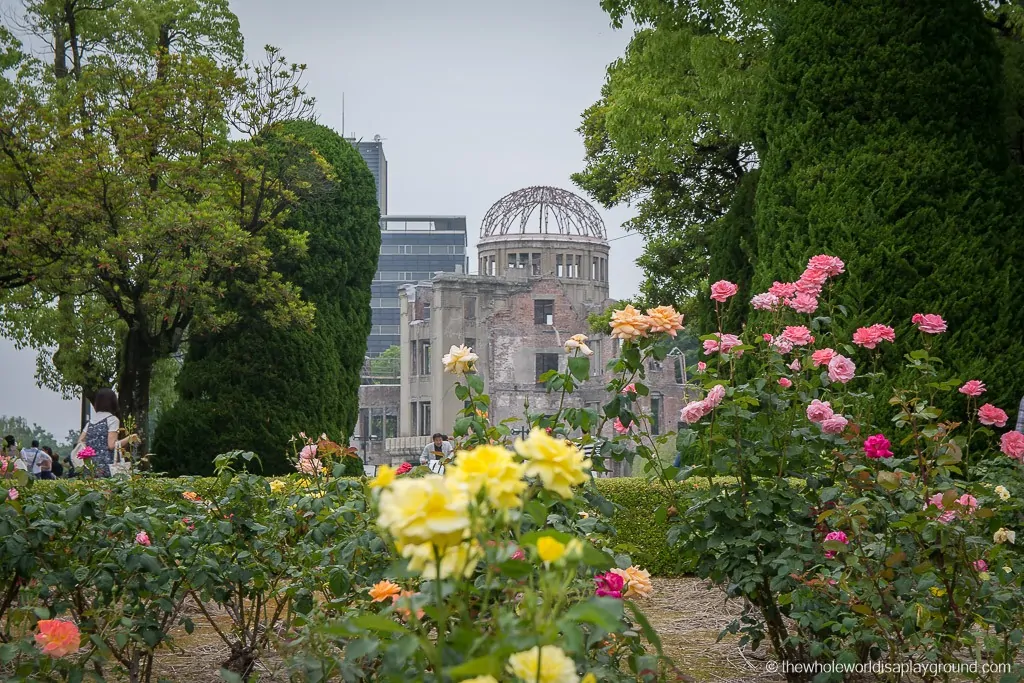
If you’re spending time in Kyoto or Osaka then a day trip to the city of Hiroshima and the small island of Miyajima is an essential part of any Japan itinerary. We spent a fascinating day exploring the sights of both Miyajima and Hiroshima and have put together our ideal itinerary for a day trip from Kyoto or Osaka. For any of you planning a day trip to Hiroshima and Miyajima here is our itinerary, sightseeing tips and details of how to get there and where to stay: happy planning!
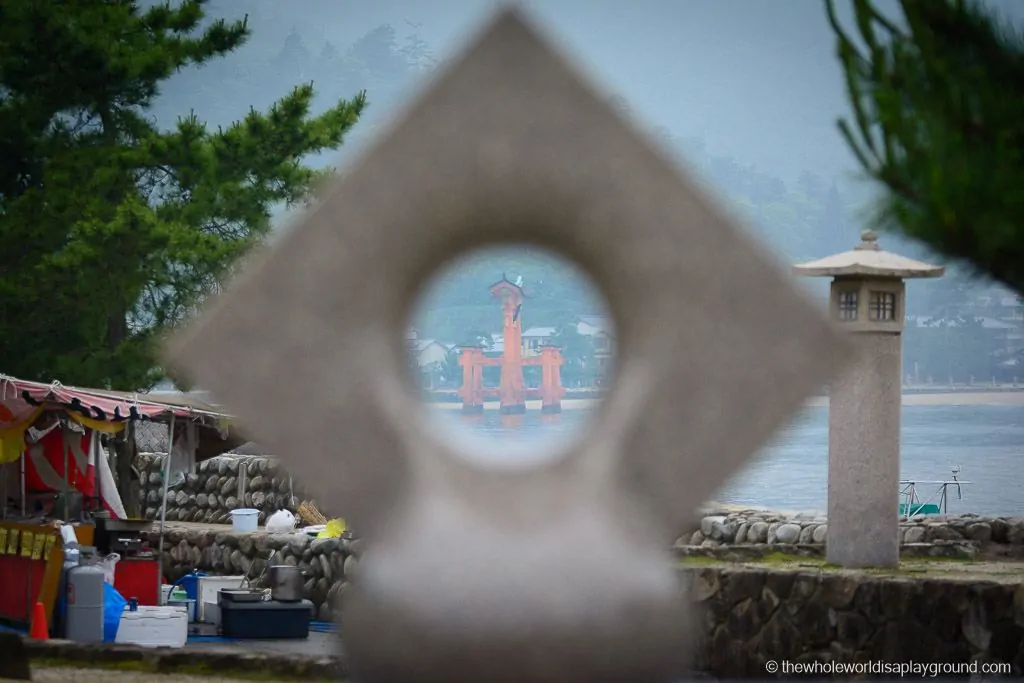
Table of Contents
How to get from Kyoto and Osaka to Hiroshima and Miyajima
There are a few train options depending on whether or not you hold a JR Pass. JR Pass holders should take a train to Shin Osaka and, from there, switch to the Shinkansen to Hiroshima. The journey takes around 90 minutes in total from Osaka and just under two hours from Kyoto.
The JR Sanyo Line takes 30 minutes between Hiroshima and Miryajimaguchi followed by a 10 minute ferry ride on the JR Miyajima Ferry to the island. It’s also possible to take a boat from Hiroshima but it’s not covered under the JR Pass – for more detailed instructions on getting to Hiroshima and Miyajima with or without a JR Pass check out our dedicated post on How to get to Hiroshima and Miyajima: day trip from Kyoto and Osaka.
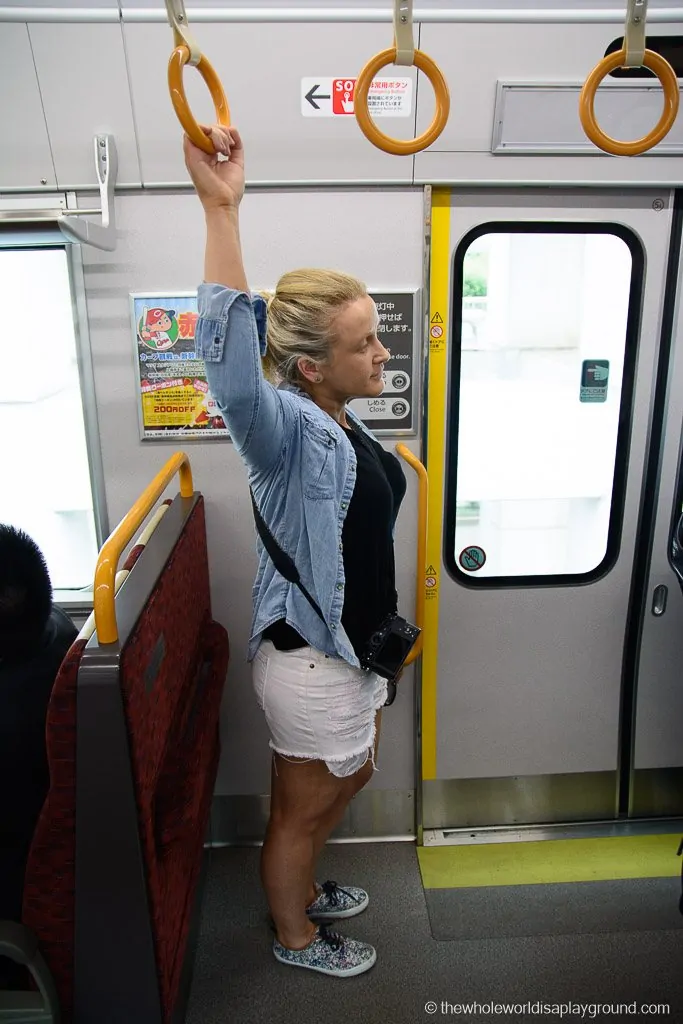
Visit Hiroshima Visitors Pass
If you are planning to visit Hiroshima and Miyajima Island we recommend purchasing a visito Hiroshima visitors Pass. The pass gives you unlimited rides on all street cars, buses and the Miyajima ferry for one, two or three days. You can purchase them in advance and it will save you time and money during your time in Hiroshima – check prices now!
Buy your Hiroshima Visitors Pass now
Where to stay in Osaka and Kyoto
Most visitors to Hiroshima and Miyajima take day trips from the cities of Osaka and Kyoto which are a train ride away – we took our day trip when we were based in Kyoto.
Where to stay in Kyoto:
- Ibis Kyoto Station: The Ibis is a great value option and, it’s so close to Kyoto station, you can catch a glimpse of the hotel from the Shinkansen platform – Check latest prices here
- Ohanabo Ryokan: Kyoto is the perfect place to experience traditional Japanese hospitality by spending a night in a ryokan. Japanese Ryokan’s have traditional futon bedding on a woven-straw floor and Yukata robes are the clothing of choice for dining and onsen visits. Ohanbo is located close to Kyoto station – Check latest prices here
Click here for Kyoto Hotel prices
Where to stay in Osaka:
- Swissotel Nankai Osaka: located on top of Namba’s Nankai station with easy access to airport train and comfortable rooms – check prices here!
- Mitsui Garden Hotel Osaka Premier: one of the more reasonably priced Osaka options with good rooms and a convienent shuttle bus from Osaka station – check prices here!
Click here for Osaka hotel prices
Morning Itinerary: Miyajima Itinerary
Miyajima is a small island off the coast of Hiroshima and is regarded as the Island of the Gods. It is an eclectic mix of Buddhist temples and Shinto shrines and wild deer roam the streets. Miyajima is home to the revered Itsukushima Shrine and its iconic floating tori gate.
Miyajima/Hiroshima itinerary tip: we recommend starting the day in Miyajima as a visit to the island is more pleasant earlier in the day before the crowds arrive. If you prefer to start with Hiroshima then hop of the train there and start with our Hiroshima itinerary guide below.
As soon as you arrive in Miyajima make your way to the UNESCO World Heritage Itsukushima Shrine. It is the main attraction on Miyajima and its floating tori gate has graced a million pictures. The iconic tori gate stands separately from the island and is beautiful at both high tide when it appears to float on the water and at low tide when it is reachable by foot so you may want to keep an eye on the tides!
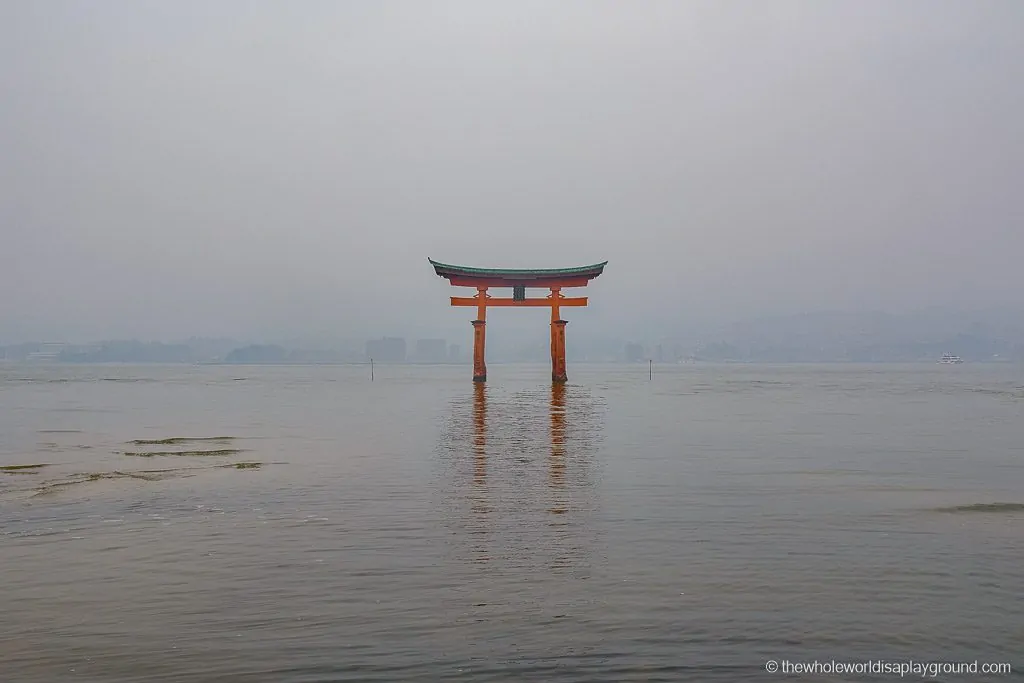
As you walk towards Miyajima keep an eye out for the wild deer which wander freely through the island . Legend has it that the deer were sacred messengers from the gods and the antics of the cute four legged creatures bring a smile to everyone’s face!
Miyajima/Hiroshima itinerary tip: the deer love being fed by the tourists so pick up some of the deer cookie which are sold throughout Miyajima.

The five story Goju-no-to Pagoda, the 1,000 Mat Pavillion and the Toyokuni Shrine are a few minutes walk from the Itsukushima Shrine. This tree lined complex is a popular spot in cherry blossom season.
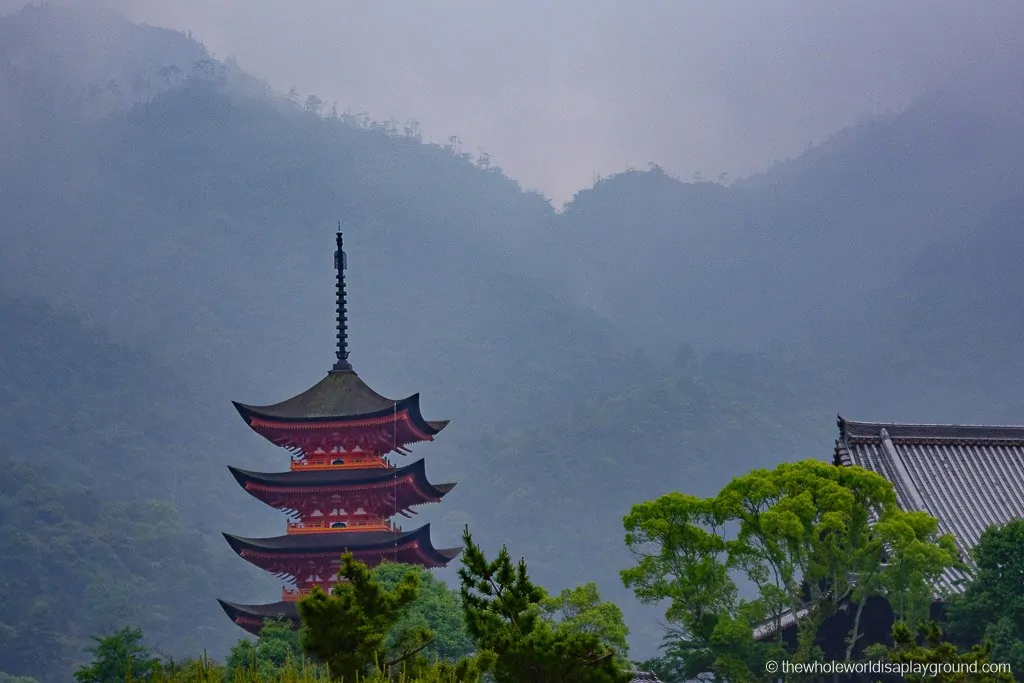
After all the exploring it’s time to hit the streets of the old town, a treasure trove of traditional architecture and quirky restaurants and bars. Be sure to indulge in some Momiji Manju, a steamed bun filled with a bean jam filling which is abundant in Miyajima.
If you’re feeling adventurous check out Mount Misen, Miyajima’s highest mountain and a perfect hiking spot which rewars with spectacular views on a clear day. The Daisho-in Temple is nestled at the base of Mount Misen and, upon entering the temple, one can turn the inscriptions on the metal wheel to benefit from the blessings of the reading of sutra.
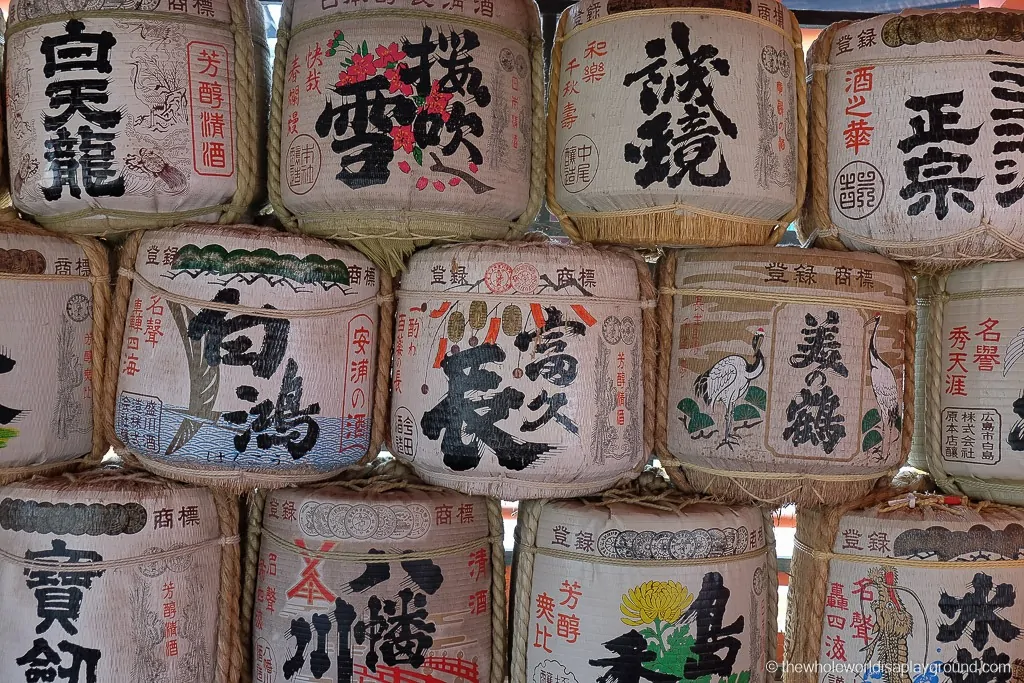
Afternoon Itinerary: Hiroshima Itinerary
Hiroshima will likely forever be known as the first city in history to have suffered the dropping of an atomic bomb, an event which occurred on August 6 1945 during World War II and resulted in the loss of life of over 140,000 people. A visit to Hiroshima offers an incredible insight into the absolute devastation of 1945 and the subsequent rebirth of the city.
At the centre of the city is the Hiroshima Peace Memorial Park and, rather than redevelop, it was decided to dedicate this area to the legacy of Hiroshima. The park contains a number of memorials to the atomic bomb.
The Atomic Bomb Dome is a key landmark in the city and sat just 160 metres from the centre of the bomb. The metal framework of the building remained intact when the bomb exploded directly overhead and the building, a designated UNESCO World Heritage Site. stands almost exactly as it did after the bomb. It remains as both a memorial and a symbol of peace.
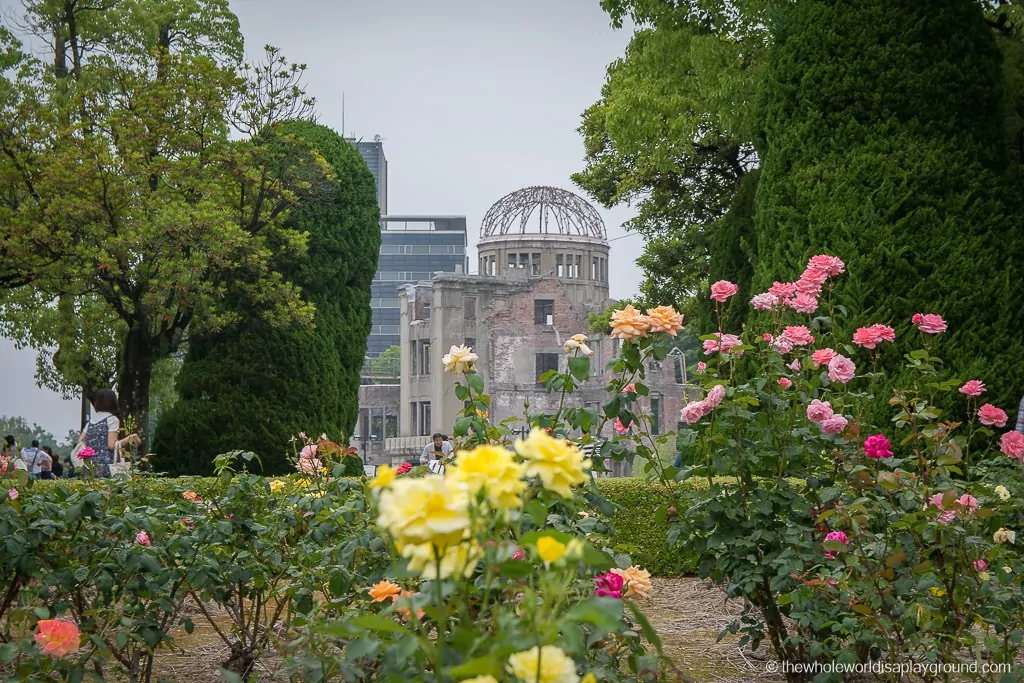
Other memorials in the park include the Centopath with its cement chest containing a list of names of everyone known to have passed from the bombing and The Peace Flame which will burn until all nuclear weapons have been eradicated from the planet. The Children’s Peace Memorial is one of the most heartbreaking features of the park and commemorates the thousands of innocent children who perished in the bomb.
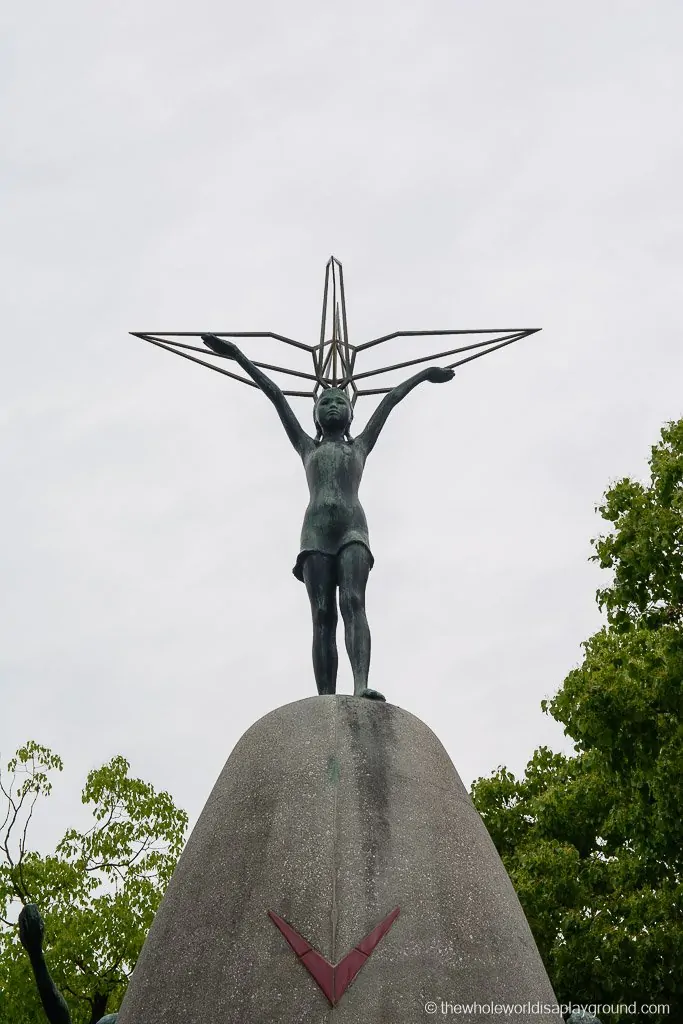
Be sure to make a stop at the Peace Memorial Museum which details the events leading to the dropping of the bomb and the devastating aftermath. It’s one of the most heart-wrenching places we’ve ever visited.
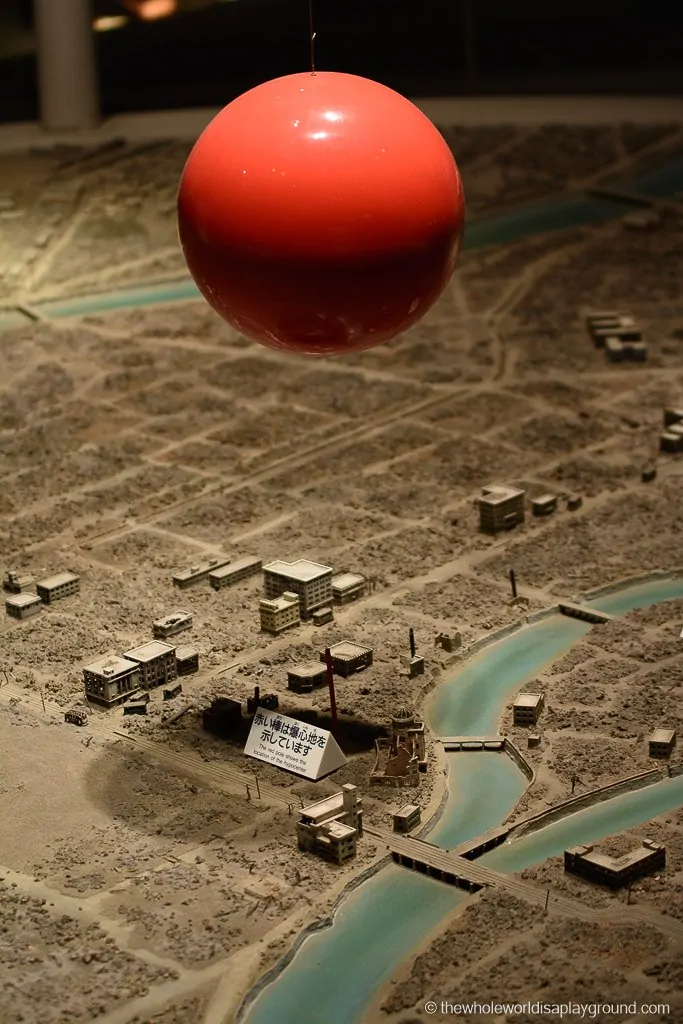
As you make your way back towards the train station check out downtown Hiroshima, a vibrant and bustling city centre filled to the brim with shops and restaurants. Indulge in the extremely tasty Hiroshima style Okonmiyaki , a fried batter and cabbage dish.
Evening Itinerary: Himjei
We made a special stop in Himjei, a Unesco World Heritage site, to visit to the city’s magnificent castle. Himjei Castle , one of only 12 original surviving castle’s in the country, is one of Japan’s most magnificent historic sites and is a designated UNESCO World Heritage Site If you prefer you can travel straight back to Kyoto or Osaka and rest up after a long day of sightseeing.
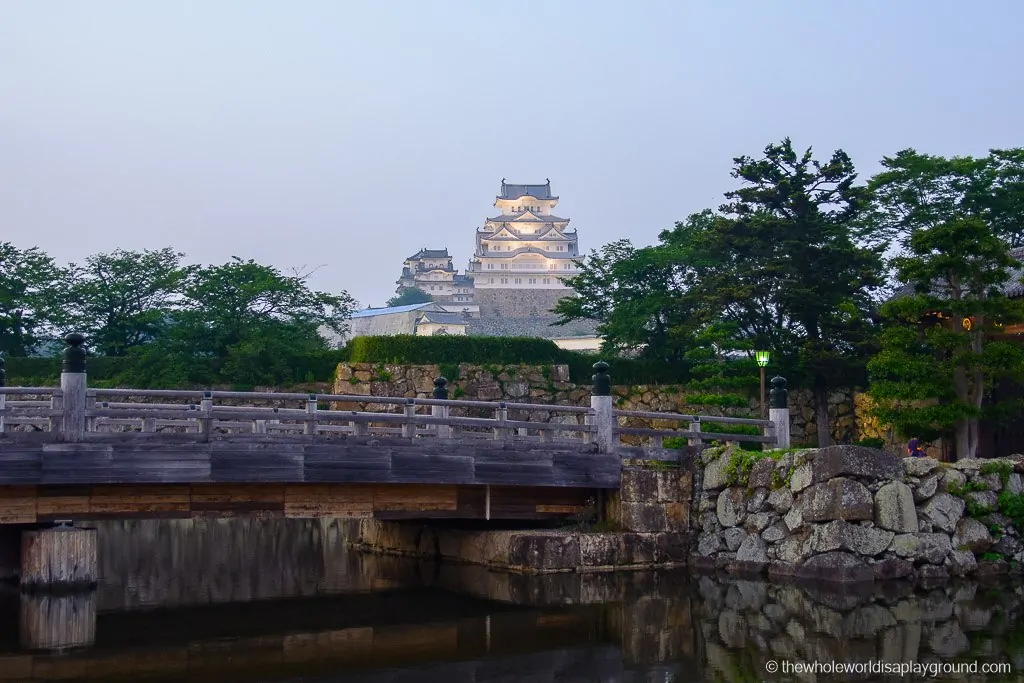
Check out our other Japan articles to help with your trip planning:
- Things to do in Miyajima and Hiroshima – read here
- How to get to Hiroshima and Miyajima – read here
- Things to do in Kyoto – read here
- Is a Japan Rail Pass worth it – read here
- A two week Japan itinerary – read here
6 thoughts on “Hiroshima and Miyajima One Day Itinerary”
Nice article! Thank you for the insightful details. We were planning to spend the night in Hiroshima, but doing this as a day trip would save us some time. I do have to mention that the program sounds quite tight. What time should we leave Osaka to make sure the whole schedules is doable?
We left at 630am and, as you say, it was a jam packed day! If you leave out Himeji Castle then you’ll have much more time – I don’t think staying over in Hiroshima is necessary in this case but maybe consider it if Himeji is high on your list.
Can you give a sample timeslot/time schedule for this trip? Im coming from kyoto as well. Thanks in advance.
We left at early, around 6:30am, to squeeze everything in. We usually start at that time as the sights are quieter but this was definitely a jam packed day!
Thanks for the useful tips guys, it made the trip much simpler & we had a great day. We could easily have spent a day each in both Miyajima and Hiroshima but we just didn’t have the time so seeing them both in one day was a good alternative. The only thing I would add is that if you don’t have a JR pass the shinkansen from Kyoto to Hiroshima is pretty expensive – about Y20,000 return so if you’re doing it as a day trip it is so much cheaper to get a JR West Kansai-Hiroshima Area Pass for Y14,500 (cheaper if you book in advance) which will cover that plus your other trains & the ferry (the one also covered by the JR pass) and lasts for 5 days so you can use it in and around Kyoto as well. Safe travels.
Thanks for the info Poppy. Agreed on the JR Pass!
Leave a Comment Cancel reply
Save my name, email, and website in this browser for the next time I comment.
Disclaimer: As an Amazon Associate I earn from qualifying purchases.

- The Ultimate Day Trip to Hiroshima and Miyajima
by Julie Jan 13, 2019 Itinerary , Japan , Travel

Remember the first time you heard those two names?
For me, 5th or 6th grade. I can’t remember which grade exactly, but I remember which part of the school my classroom was in, so it must have been one of those two grades.
I even remember where I was sitting: round table in the back of the classroom.
My classmates and I were shown a film about the dropping of the first atomic bomb. Thank goodness the film did not spare any of the gory details: charred bodies, burned victims, and radiation poisoned survivors. I’ll never forget the shadow of a person that had been permanently imprinted on a wall. It left an indelible impression on me. Human beings are cruel. Governments are cruel. And from that moment on, I strongly believed that the United States had been wrong to have used a nuclear weapon on Japan.
I even remember the first time I met someone from Hiroshima. I was living in China, and I was having lunch with some Japanese classmates from my Chinese class at the university. When my classmate told me she was from Hiroshima, I immediately felt ashamed and embarrassed. She must really hate me I thought. I wanted to apologize to her. However, since I’m really bad at expressing my emotions, I said nothing.
And then I decided to go to Japan. Like I always do, I downloaded tons of books onto my Kindle and borrowed even more from the library.
I’m a nerd and what nerds do is they do a lot of research. And so I read and read as much as I could about Japan.
And the more I read, the more I became uncertain about the bomb. Was it really necessary? Maybe it was, or maybe it wasn’t. I just wasn’t sure anymore. Was the U.S. justified?
From 1937 to 1945, 24 to 32 million died in Asia. 10 to 20 million of those people were from China. 1 to 2 million were from Vietnam, Cambodia, and Laos. 3 million were Japanese. Comfort women. Nanking. Sook Ching. But a nuclear weapon? That is the worst cruelty of them all, isn’t it?
I had to go to Hiroshima and see for myself. Maybe the city would have some answers for me. And so I embarked on a trip to Hiroshima in search of the answer to this burning question: to end the war, was it necessary for America to drop an atomic bomb on not one but two Japanese cities killing between 100,000 and 200,000 people?
I found that as I toured the one remaining building, a park and a museum, my views changed in a surprising way from the beginning of my visit to the end.
Here are some of the books that I have read as I searched for answers. Following that, is a 1-day itinerary for both Hiroshima and Miyajima. Sprinkled in between the itinerary are my thoughts and feelings and a bit of history.
Disclosure: This post may contain affiliate links. As an Amazon Associate and a Bookshop.org Associate, I earn from qualifying purchases. Please see this website's Disclosure for more info.
In This Post, You'll Find...
- 7:00 am – Leave Kyoto
- 9:00 am – Arrive in Hiroshima
- 10:00 am – Atomic Bomb Dome
- 10:20 am – Peace Memorial Park
- 11:00 am – Hiroshima Peace Museum
- 1:00 pm – Lunch
- 2:00 pm – Travel to Miyajima
- 3:00 pm – Arrive in Miyajima
- 5:00 pm – Leave Miyajima
- 6:00 pm – Dinner
- 7:00 pm – Leave Hiroshima
Hiroshima is located about two hours by train from Kyoto and an hour and a half by train from Osaka, making it an easy day trip from either city.
Hiroshima is such a nice city that one would be hard-pressed to associate it with the dropping of the first atomic bomb. The only real reminders of that event are a park, a museum, and the remains of one building.
The city, though, is more than just this tragedy. For foodies, Hiroshima is famous for its okonomiyaki, a Japanese version of a pancake. It’s super unhealthy but very delicious! It’s also different from other versions of okonomiyaki. And Hiroshima is famous for oysters. You can have okonomiyaki with oysters.
There are several museums and a castle in the city as well. However, since the museums are not as good as those in other cities and the castle is a complete replica, I think a Hiroshima 1-day itinerary is enough.
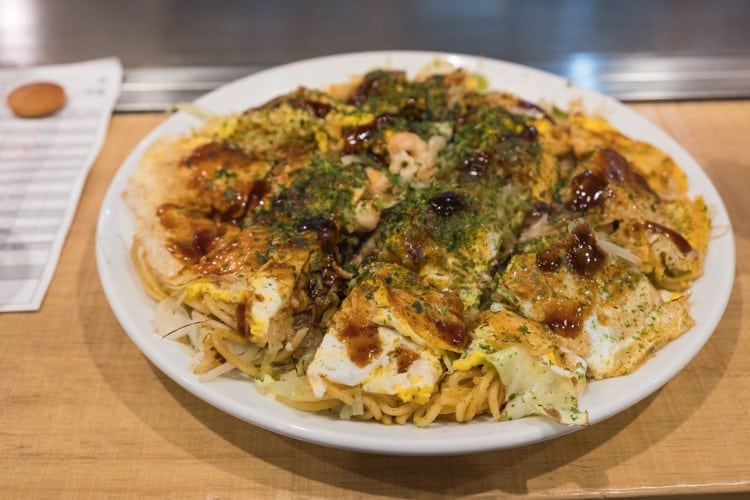
The other part of your journey is a trip to Miyajima. Miyajima is a small island that is around 45 minutes by train and ferry from Hiroshima. It’s famous for being one of the top three most scenic spots in Japan with its iconic floating torii gate . .

If you’re short on time, you can easily make a Hiroshima and Miyajima itinerary into a day trip from Kyoto or Osaka. I’ve outlined the perfect Hiroshima and Miyajima 1-day itinerary from Kyoto , but you can do this trip even more easily from Osaka. I’ve outlined how you can turn your Hiroshima and Miyajima visit into a day trip.
You can tour these two places by touring Hiroshima in the morning and visiting Miyajima in the afternoon or vice versa and see Miyajima in the morning and Hiroshima in the afternoon.
BONUS: I've created a FREE detailed PDF version of this 3-week Japan itinerary. The guide also includes step-by-step instructions for buying and using your Japan Rail Pass.
Click here to get lots of great tips for traveling around Asia as well as this FREE 3-week Japan itinerary guide.
Hiroshima + Miyajima Itinerary
7:00 am – leave kyoto or osaka by train.
To complete a Hiroshima and Miyajima itinerary in one day, you’ll need to start out early in the morning from Kyoto (or Osaka). As of January 2019, the Shinkansen (bullet train) Hikari train departs Kyoto at 7:20 am and arrives in Kyoto at 9:05 am. You can use your Japan Rail (JR) pass for this train. If you don’t have a JR pass, it’ll cost you ¥6,480 (US$61 / €52 / £47) from Kyoto .
⇒ Please check the train times on Hyperdia .
9:05 am – Arrive at Hiroshima JR Train Station
Once you arrive at the Hiroshima JR Train Station, go immediately to the tourist information center inside the station. Ask for all maps of Hiroshima, transportation information, a free Hiroshima sightseeing guide called Seeking Hiroshima, and the train schedule to Miyajimaguchi , where you get the ferry to Miyajima.
Make sure to ask them where to catch the bus for the Atomic-Bomb Dome.
Getting to the Atomic Bomb Dome and the Peace Park
Hiroshima has 3 sightseeing buses that are free for Japan Rail pass holders . If you don’t have a JR Pass, it’s ¥200 (US$1.85 / €1.60 / £1.45) per ride or ¥400 (US$3.70 / €3.20 / £2.90) for a day pass. You can catch these buses from the train station outside the Shinkansen entrance. The tourist information center will point the way.
The buses are the Green Route, the Lemon Route, and the Orange Route . Unfortunately, the names of the buses have nothing to do with the colors of the buses. They only correspond to the colors of the routes on the map.
- Green Route : Runs every 30 minutes. It starts at 9:00 am until 5:45 pm.
- Lemon Route: Runs every 20 to 30 minutes. It starts at 9:30 am until 5:30 pm.
- Orange Route : Runs every hour. It starts at 9:00 am until 5:00 pm.
All loop sightseeing buses start and stop at the JR Hiroshima Train Station and all of them pass by the A-Bomb Dome, the Peace Memorial Park, and the Peace Memorial Museum. The only difference is that they take different routes and times to get there. They are the perfect way to get around during your Hiroshima itinerary.
To the A-Bomb Dome and Peace Museum, the Green Route is the fastest . It goes directly to the A-Bomb Dome and gets you there in 3 stops. In 2018, the bus left at 9:45 and took about 15 minutes to get to the Atomic Bomb Dome.
(COST: Free; OPEN: 24/7)
Start your Hiroshima 1 day itinerary at a place that perfectly exemplifies the power of human beings to destroy each other. Situated on the bank where the Honkawa River splits into two, stands the remains of the Hiroshima Prefectural Industrial Promotion Hall which had been designed by a Czech architect. The bomb exploded pretty much directly above the dome killing everyone inside.
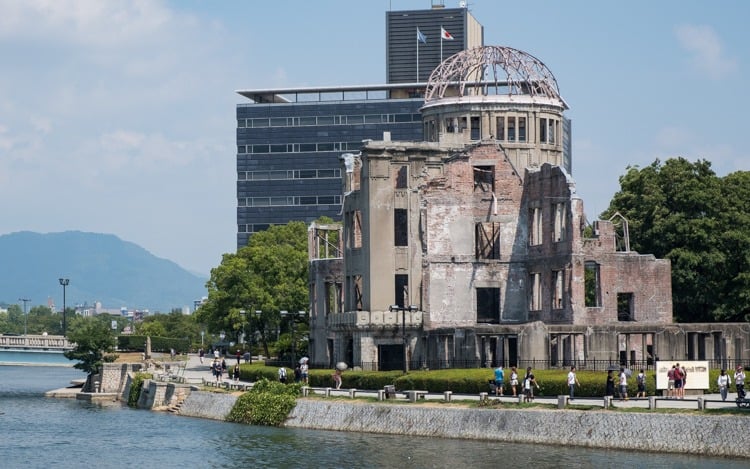
In early 1945, the United States started conducting incendiary bombing raids on Japanese cities, indiscriminately killing tens of thousands of people per raid. It was easy for the buildings to catch fire and for the fires to spread since Japanese buildings at that time were predominately built out of wood.
By the end of the war, 50% of Tokyo had been destroyed and over 100,000 Tokyo civilians had died.
To give you more of an idea of how much Japan lost from the war, 26% of Osaka, 31% of Nagoya, 44% of Yokohama, and 51% of Kobe had also been destroyed.
Hiroshima had been one of the few major cities (Kyoto and another city) that hadn’t been bombed by the Americans.
Not having been attacked yet, Hiroshima turned out to be the perfect testing ground for the atomic bomb as the Americans could thus get “an unbiased assessment” of its power ( History of Japan podcast ).
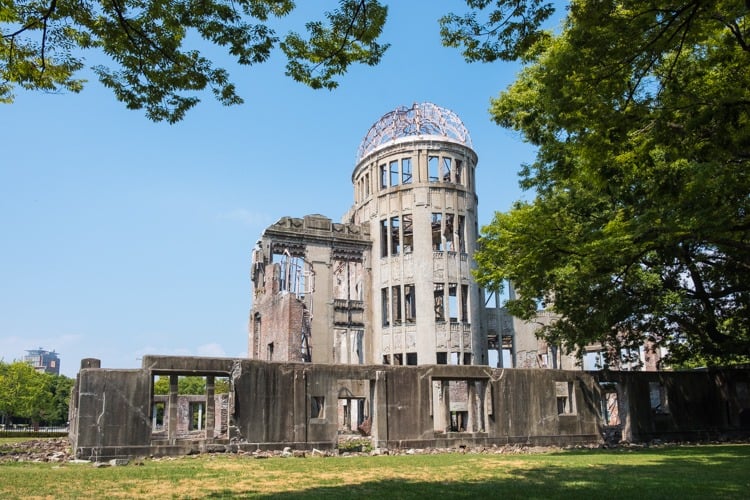
The Prefectural Hall was not the only building still standing after the bomb fell. 62,000 of 90,000 buildings were destroyed and 6,000 became unrepairable. However, the Hall was the last building that was set to be demolished in the 1950s. Instead, it was decided to preserve it as a reminder of the consequences of war. In 1996 it became a UNESCO World Heritage Site.
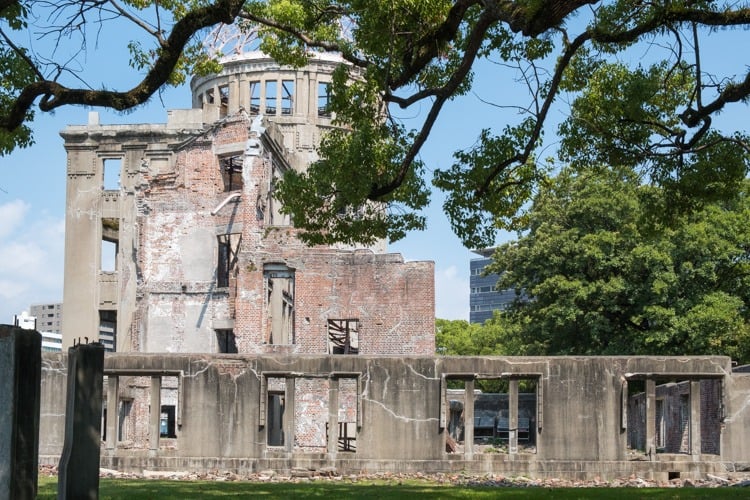
I was quite moved by the site of this building. It really hits home how futile war is. Why did the Japanese start this war? Why did the people go along with it for so long? Was it really necessary to drop the atomic bomb on innocent civilians?
You might be interested in these Japan travel posts:
- Kyoto Itinerary 4 Days: A City of a Million Temples
- The Best Ever Guide to the Tateyama Kurobe Alpine Route
- Kamikochi Hiking: A Perfect Day Trip from Takayama
10:30 – Peace Memorial Park
After walking around the dome and contemplating what it means, continue your Hiroshima itinerary by crossing the bridge to the Peace Memorial Park.
There are tons of monuments throughout the park to honor the victims of the atomic bomb. If you’re going to make this visit a day trip, there just isn’t time to see them all. Look at your map and the list of monuments and decide which ones you’d like to see. I wanted to see the Monument Dedicated to Korean Survivors and Victims, but I couldn’t find it.
However, there are a few Must-Sees in the park that you should include in your Hiroshima 1-day itinerary.
1. Peace Bell
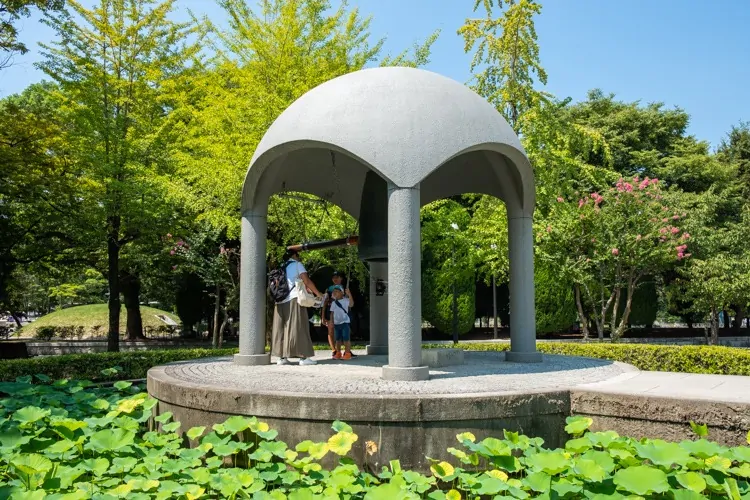
2. Children’s Peace Monument
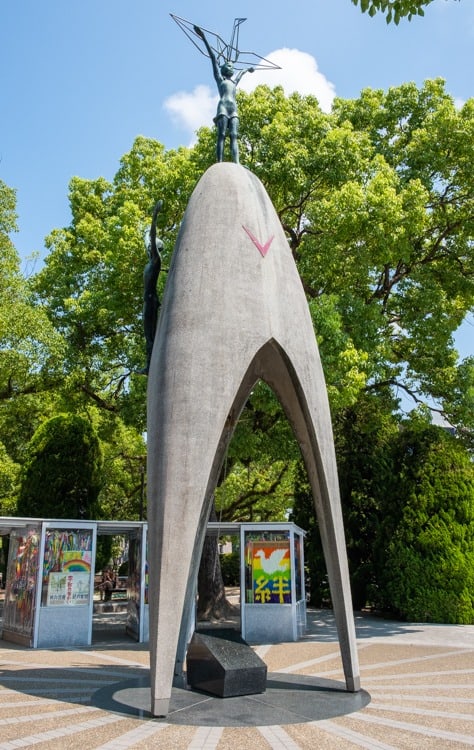
Sadako Sasaki was 2 years old when the bomb was dropped. At the age of 11, she got leukemia. She decided to make 1,000 paper cranes, which means longevity and happiness in Japanese. She thought that if she could make them all, she would get better. She didn’t make it. But her classmates folded the rest. This statue was built in her honor.
At the top, you can see a statue of a girl. There are also colored paper cranes made by school children from Japan and the world in glass cases at the back of the statue.
How many people died from the bomb and how did they die?
We are not sure of the exact number, but it’s estimated that between 90,000 and 140,000 died out of the 245,000 people who were in Hiroshima at the time of the bomb.
25% died from direct burns, 50% from other injuries, and 25% from radiation.
I don’t know if these numbers include those people who got cancer years later.
Would Sadako have gotten leukemia if she hadn’t been in Hiroshima at the time the bomb was dropped?
It is true that people who were in Hiroshima during the bomb had higher rates of cancer, especially leukemia, than normal. If a survivor were less than one kilometer from the epicenter, they had a 10-50 times greater chance of getting cancer than those further away.
Other effects of the bomb included higher rates of cataracts, anemia, liver dysfunction, sexual problems, and endocrine disorders. Survivors also aged faster.
Children tended to grow up stunted. If they were in their mother’s womb at the time of the explosion, they were more likely to be born with smaller heads.
Chromosome aberrations were also found in the DNA of survivors.
You might be interested in these posts:
- Japan Itinerary: How to Spend 3 Perfect Weeks in Japan
- Tokyo Itinerary: 4 Days in the Greatest City in the World
- Hakone Itinerary: A Guide for 2 Fabulous Days in Hakone
3. The Flame of Peace
Next, continue your Hiroshima itinerary by visiting the Flame of Peace. The Flame of Peace has been burning since August 1st, 1964, and it will not be extinguished until all nuclear bombs are destroyed.
If you’re seeing this flame in the daytime with blue skies, it’s not very visible.
The base of the monument looks like hands spread out facing the sky.
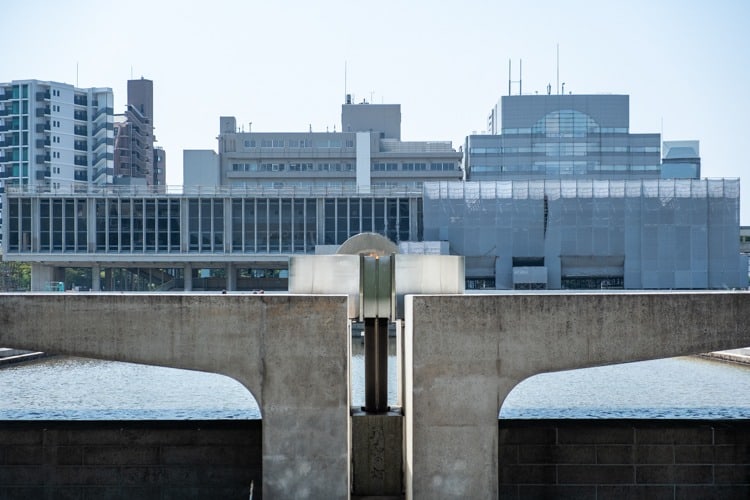
4. Cenotaph for the A-Bomb Victims
The next stop in your Hiroshima 1 day itinerary should be a stop at the Cenotaph for the A-Bomb Victims.
The stone tomb underneath the arch holds the names of all the victims of bombs. If you look through the gap underneath the arch of the Cenotaph, you can see the A-Bomb Dome.
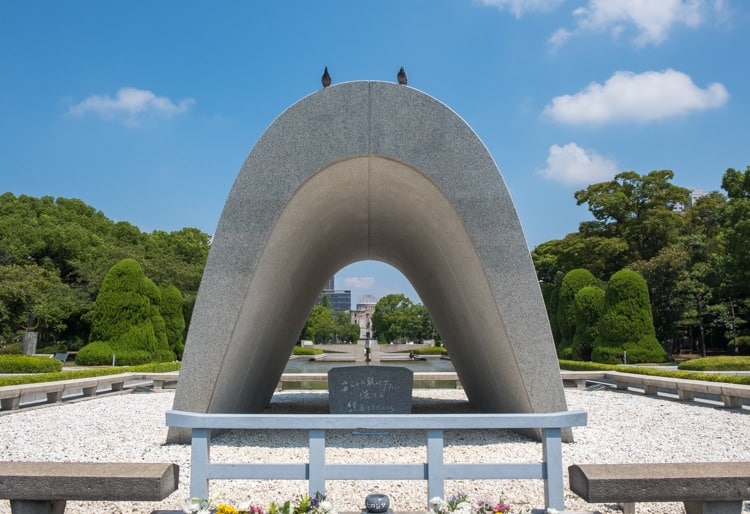
The arch is shaped like a haniwa , which was used on tombs in prehistoric Japan.
5. Hiroshima National Peace Memorial Hall for the Atomic Bomb Victims
(COST: Free; OPEN: 8:30 am – 6:00 pm; Aug – 8:30 – 7:00 pm)
A short distance from the Cenotaph is an underground hall called the National Peace Memorial Hall for the Atomic Bomb Victims. There is a panoramic view of Hiroshima inside.
(COST: ¥200 (US$1.85 / €1.60 / £1.45) for adults; ¥100 for high school students; junior high and younger: free; OPEN: Mar-July 8:30-18:00; Aug: 8:30-19:00; Sep-Nov: 8:30-18:00; Dec-Feb: 8:30-17:00)
The most important stop on your Hiroshima itinerary will probably be the Hiroshima Peace Museum.
The museum is part of a very large 3-building structure. The museum is usually located in the Main building and the East building. However, when I was there, the Main building was under renovation, so everything had been moved to the East building. The west side is the International Conference Center, Hiroshima, which you can ignore.
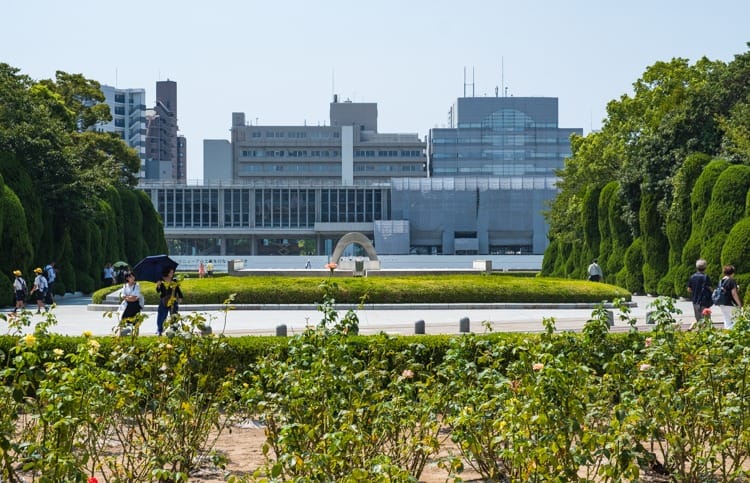
An audio guide in English costs ¥200 (US$1.85 / €1.60 / £1.45), but you’ll find that what is on the audio is the same as what is written on the exhibits.
There are coin lockers to store your bags.
The permanent exhibits begin on the 3 rd floor. Make sure to follow the numbers on the map so that you don’t miss anything good. I missed the individual video booths.
Exhibit #1: A Lost Way of Life, 3rd Floor
Not to be missed is an amazing video display of Hiroshima before and after the bomb.
I found seeing the instant obliteration of Hiroshima to be fascinating and moving. Nuclear bombs make war too easy and with too little consequences for the aggressor.
Exhibit #2: A-bomb Survivors Video Testimony (Third Floor)
After the video display, you can head to the A-bomb Survivor Video Testimony. There is a large room with seating to watch interviews of survivors of Hiroshima. These interviews are quite moving.
There are also individual video booths, but I, unfortunately, overlooked them.
Japan has a special word to describe those who survived the Hiroshima and Nagasaki bombs: hibakushas , which is translated as “explosion-affected person.”
Hibakushas did not receive any aid from the government until 1954 when the Japanese people became outraged that 23 crew members of a Japanese fishing boat had become poisoned with radiation from a nuclear weapons test by the United States at Bikini Atoll. As a result of this anger toward the U.S., the government finally passed a law giving Hibakushas free medical treatment and a monthly allowance. In 1975, a law was passed to increase the allowance.
Hibakushas were often discriminated against. They sometimes had trouble finding work because employers thought they would miss work too often from illnesses due to the bomb.
Although the primary symptoms of radiation poisoning like vomiting, diarrhea, and hemorrhaging of blood vessels would wear off after a while, many did have health problems their whole lives. They suffered from “weakness, weariness, dizziness, digestive problems, and feelings of oppression and doom.”
Exhibit #3: The Dangers of Nuclear Weapons (Third Floor)
In this part of the museum, there are exhibits along a wall telling the history of the development and dropping of the atomic bomb on Hiroshima.
There is also a really cool interactive media table in the center of the room. I couldn’t tell if all of the monitors showed the same thing or were different.
Exhibit #4: Hiroshima History (Second Floor)
On the second floor is another exhibit on the history of Hiroshima during and after the war.
Exhibit #5: Outline of Atomic Bomb Damage (First Floor)
This is a fascinating exhibit with clothing and items from people who had died and oral histories from people who survived in the beginning.
I’ll be honest with you that although I was deeply moved to tears during the video testimonies, by the end of my visit I was annoyed for a number of reasons.
First of all, the museum got some of their facts wrong and second, they presented the bomb without the context of the whole war.
What did the museum get wrong? I had planned to tell you what they got wrong in this section, but as I did more research and learned more about the bomb and the war, my explanation grew and grew and became too long to properly fit in this space. I’ve included my explanation and my conclusion about whether the bomb was necessary in the conclusion of this post.
Check Out These Hidden Gems:
- Takayama Itinerary: How to Spend 2 Days in Japan's "Little Kyoto"
- Travel Guide to Shirakawago: Enter a Japanese Fairy Tale
- Day Trip to Nara: A Suggested Itinerary
1:00 – Have Lunch
Once you leave the museum, you can head to the bus stop on the other side of the museum to stop #7, Peace Memorial Park, and catch the bus back to the train station. The Lemon Route is the fastest.
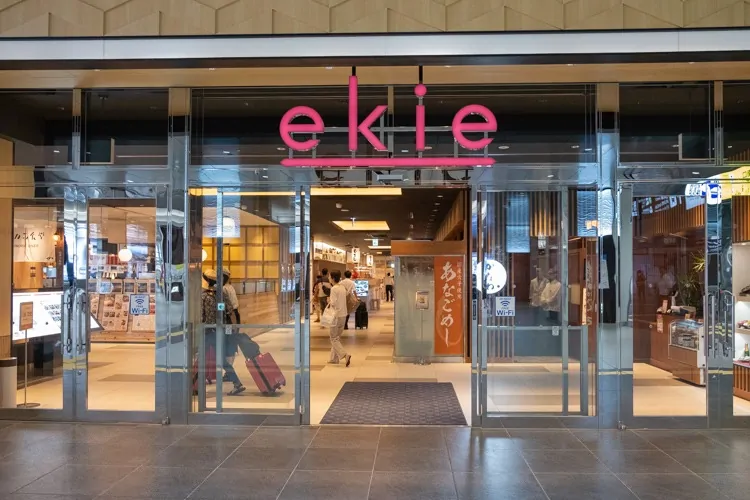
I went to this food arcade place at the train station called Ekie . There are several nice restaurants at the train station serving a variety of different foods. I chose one that served okonomiyaki. You can sit at a bar around the griddle watching the chefs cook the okonomiyaki. It’s kind of cool and fun!
I’m sure there are better and more famous restaurants in Hiroshima, but the restaurants at the train station are super convenient. If you’re going to really do this Hiroshima and Miyajima itinerary in a day, time is gonna be precious.
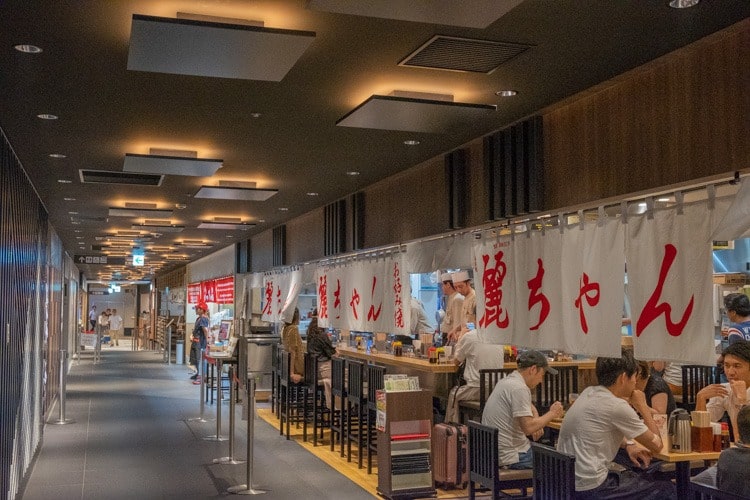
Hiroshima is famous for its okonomiyaki, which consists of layers of batter, noodles, cabbage, vegetables, and seafood or meat. Make sure to try them with oysters as Hiroshima is also famous for them. You can also get the okonomiyaki with cheese. I didn’t try the cheese one, but a traveler I met along the way who I had dinner with had it and said it was delicious.
2:00 pm – Take the Train and Ferry to Miyajima
Miyajima is a small island located so close to Hiroshima that you can easily make a day trip out of your Hiroshima 1 day itinerary. Miyajima is famous for the iconic torii gate floating in the water.
How to Get to Miyajima
Getting to Miyajima is easy as pie. In fact, there are 3 different ways to get there:
1. JR Train + JR Ferry
2. World Heritage Sea Route Ferry from Hiroshima Peace Park
3. Streetcar + JR Ferry
I’ll explain each of the ways below:
The train and ferry are free with your JR Pass.
Without a JR Pass, the total cost would be ¥600 (US$5.50 /€4.80 /£4.30) one way.
This method involves a 30-minute train ride, a 5-minute walk, and a 10-minute ferry ride. It doesn’t include wait times. All times are approximate.
Here are the steps in more detail:
STEP 1: JR Train
Take a local JR train (Sanyo Line) from Hiroshima station to Miyajimaguchi. It takes 30 minutes, and it’s free with your JR Pass .
If you don’t have a JR Pass, it costs ¥400 (US$3.67 / €3.21 / £2.88).
Below is the train schedule from August 2018. Stop by the Tourist Information Center at the train station for a more up-to-date schedule.
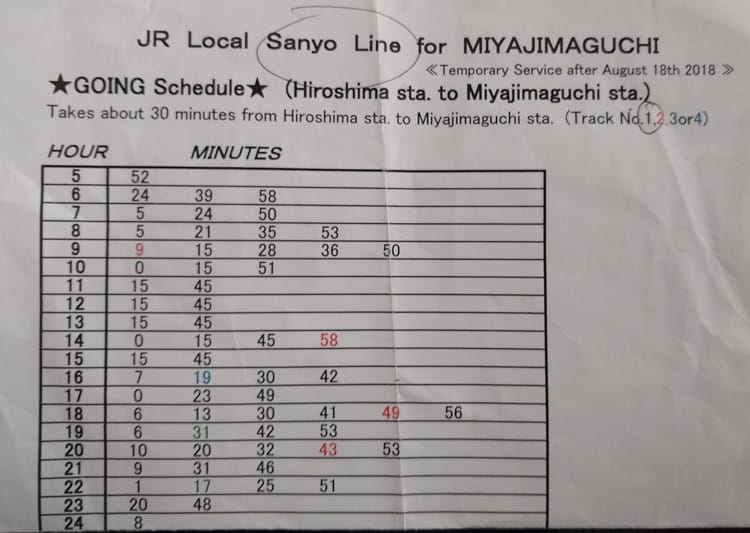
It’s a local commuter train so it’s going to stop at every single station along the way. Be patient and take a seat.
Just an FYI, some of the stations that the train stops at are not listed on the map that you get from the tourist center. While on the train, keep an eye out for the Miyajimaguchi sign on the station platform to tell you when to get off.
STEP 2: Walk
Walk about 2 blocks or 5 minutes to the ferry terminal.
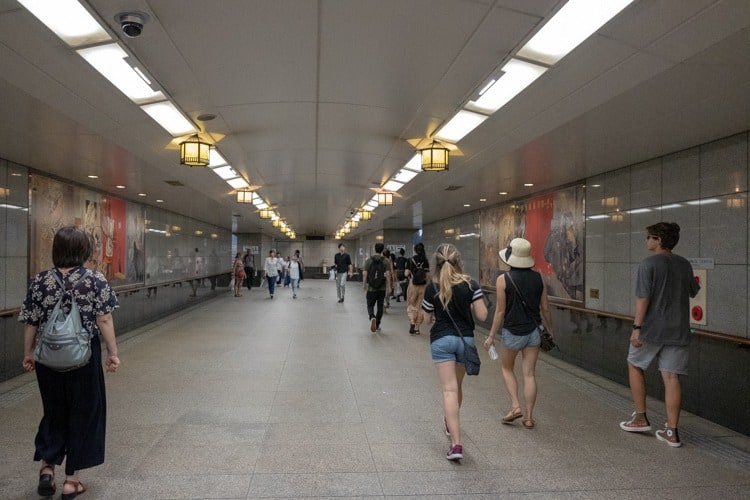
There are signs pointing the way to the terminal. You won’t get lost.
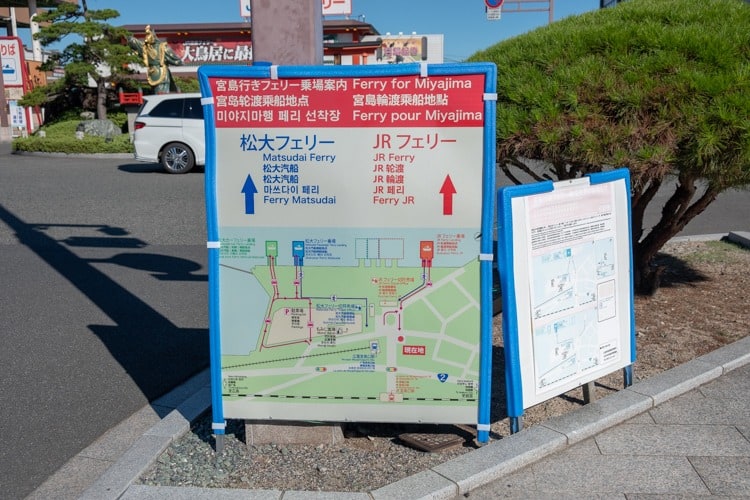
STEP 3: Ferry
Take the ferry to Miyajima island. There are two ferry companies that cover this route: Japan Rail and Matsudai. Only the ferry ride with Japan Rail is covered under your JR Pass. It takes 10 minutes. If you don’t have a JR Pass, it costs ¥180 (US$1.65 / €1.44 / £1.30) one way for adults and 90 one way for children. You can use your Plasmo or Suica to pay.
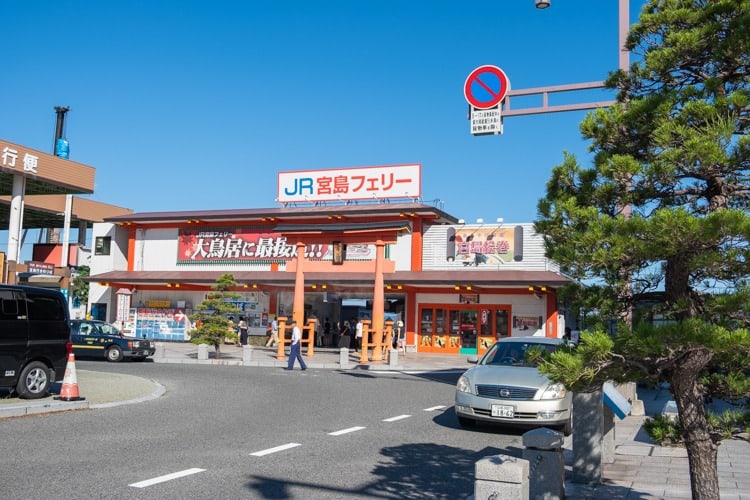
According to the ferry schedule as of December 30, 2018, ferries from Miyajimaguchi to Miyajima run from 6:25 am to 10:45 pm usually every 15 minutes. From Miyajima to Miyajimaguchi, they run from 5:45 am to 10:14 pm.
⇒ You can find the timetable for the JR Miyajima Ferry here .
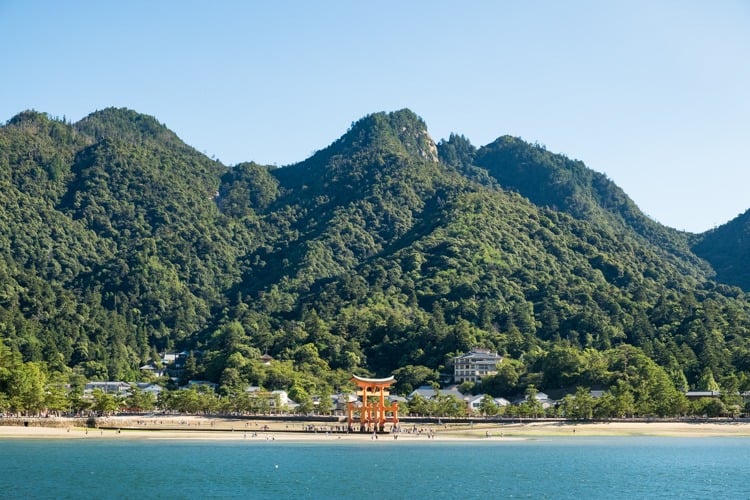
Don’t worry. You won’t get lost. Just follow the crowds and signs to the ferry.
2. World Heritage Sea Route Ferry from the Peace Park
There is also a direct ferry to Miyajima from Hiroshima Peace Park called the Hiroshima World Heritage Sea Route.
It costs ¥2,000 (US$18.37/€16/£14.42) one way and ¥3,600 (US$33 /€29/£26) round-trip.
It takes 45 minutes and leaves every 30 minutes.
⇒Click here for the website with timetable :
You can also take a streetcar (¥280/US$2.57/ €2.25/£2 one-way) to Miyajimaguchi. This is the most expensive.
From the Atomic Bomb Dome to Hiroden Miyajimaguchi, the streetcar takes around 55 minutes.
From the train station to Hiroden Miyajimaguchi, the streetcar takes around 75 minutes.
Then take the JR ferry from the Miyajimaguchi Pier, which is another 10 minutes.
When you get off the ferry, grab a free map from the tourist information center at the ferry terminal.
You’ve already seen the torii gate from the ferry, so it’s not rocket science that you need to turn right and walk along the water to get to it. It takes 12 minutes to get to the torii gate.
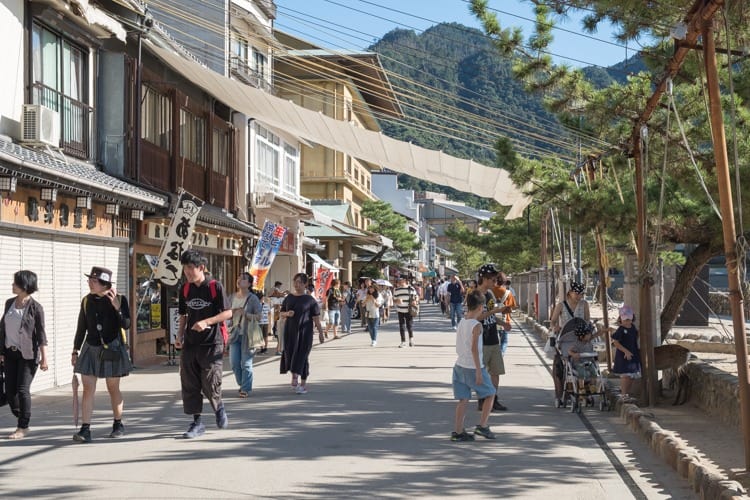
There are two roads that you can take to get to the torii gate. There is one footpath that goes right along the water. The other is along Omotesando street, one block from the footpath. Souvenir shops and restaurants line this street.
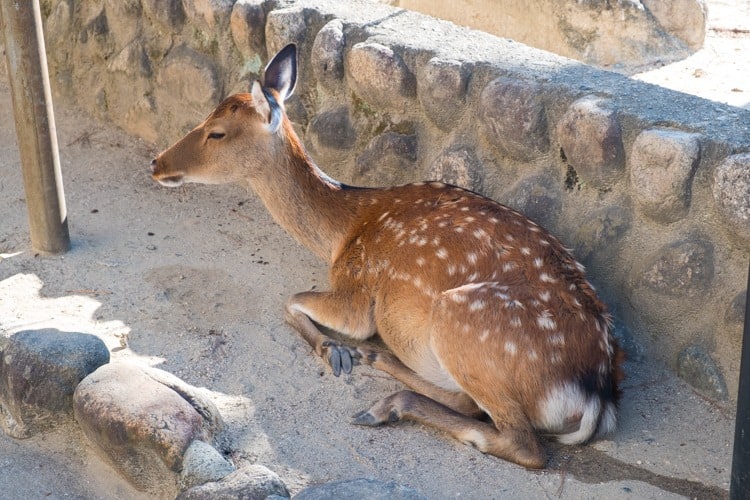
As you walk to the torii gate, you’ll notice lots of overly friendly and hungry deer just like in Nara. Just a warning: if you have some paper in your hand or pocket and it’s visible to the deer, they won’t ask before taking it to eat. While I was looking at a map, one deer came over to me and took it right out of my hand and started chewing on it.
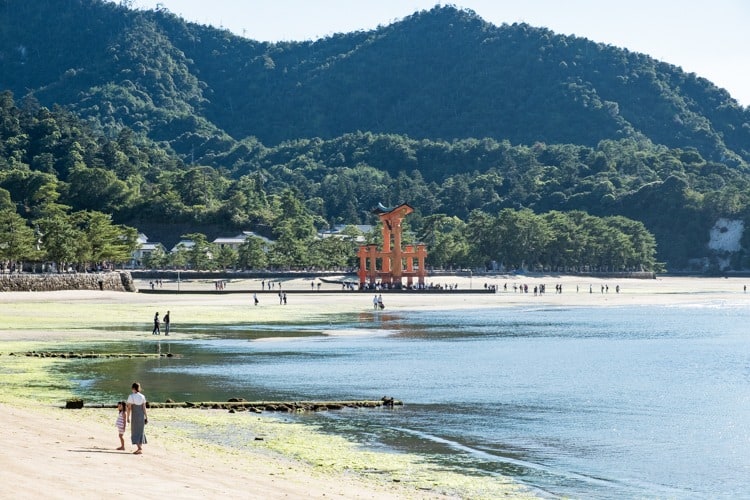
Unlike in Nara, there are signs asking people not to feed the deer as it has made the deer dependent on handouts from food, upsetting its natural eating habits. I agree.
Miyajima is also famous for oysters, so if you’re hungry and eat seafood, you can grab some from restaurants along the way to the torii gate.
Torii Gate of Itsukushima-jinja Shrine
The floating torii gate is a vermillion-colored gate that sits out in the ocean. It is actually the entrance to the Itsukushima Shrine.
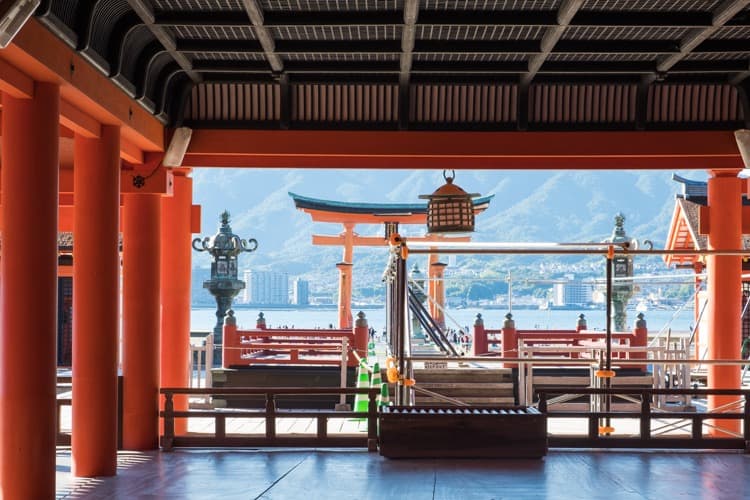
Why is it in the ocean?
According to Lonely Planet Japan, long ago people were not allowed to set foot on Miyajima, so if they wanted to enter the Itsukushima Shrine, they had to enter from the ocean; hence, the torii gate, which is how you enter all shrines, was built out into the sea.
Pay attention to whether the tide is low or high. If the tide is high, the sea will be surrounding the torii gate like above. If it’s low, it will be like the pictures below.
⇒ You can check out this website, Get Hiroshima, for all of the tide times for 2019 !
⇒ There’s another website that gives more information on tide times for Miyajima.

I went when the tide was low and well, you can see from my picture what it looked like when I was there.
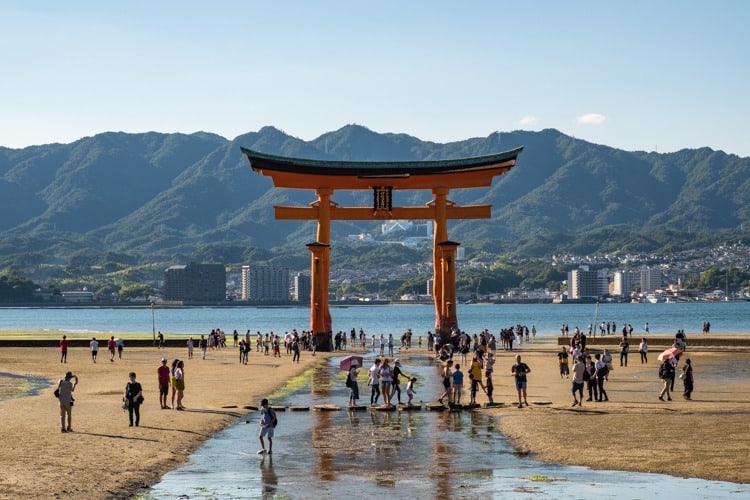
Lots of people told me how spectacular the view of this torii gate is, but I wasn’t all that impressed and I think it was because it was low tide.
If the tide is low, you can get to it from the beach and you don’t need to go through the shrine; thus, you avoid paying the entrance fee. The shrine is nothing special, and if you’ve seen lots of shrines already, you won’t be sad to miss this one.
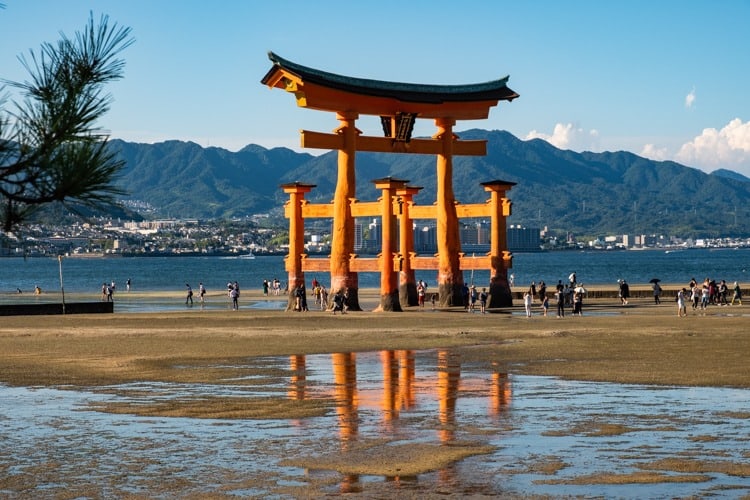
Night views of the torii are supposed to be spectacular. Of course, the sun sets at different times depending on the time of year, so if it sets before you need to leave to make the last train back to Kyoto or Osaka, you can stick around and take some awesome photos of the torii gate with the setting sun behind it.
Miyajima Light-up Night Cruise: You can also take a night cruise to Miyajima and see the torii gate all lit up. The cost is ¥1,600 (US$15/€13/£12) but I don’t know if that is one way or round trip. The first cruise leaves at 5:55 pm arriving at 6:25, and the last cruise leaves at 9:15 pm arriving at 9:45
⇒Click here for the website with a timetable
Looking for Travel Info on Tokyo?
- Where to Stay in Tokyo
- 4 Best Day Trips from Tokyo
- Tokyo Itinerary: How to Spend 4 Days in Tokyo
Getting Back to Kyoto or Osaka
What time you leave Miyajima depends on what time you want to get back to Kyoto or Osaka.
4:55 pm or 5:10 pm – Ferry from Miyajima to Miyajimaguchi
I would leave Miyajima at 4:55 or 5:10 pm in order to have dinner in Hiroshima.
⇒ Click here for the JR ferry schedule .
5:30 or 5:39 – Train from Miyamiguchi to Hiroshima
For those needing to leave Hiroshima at 7:22 pm, take the 5:30 pm or 5:39 pm train back to Hiroshima station. It should take 30 minutes. Here is the train schedule from 2018:
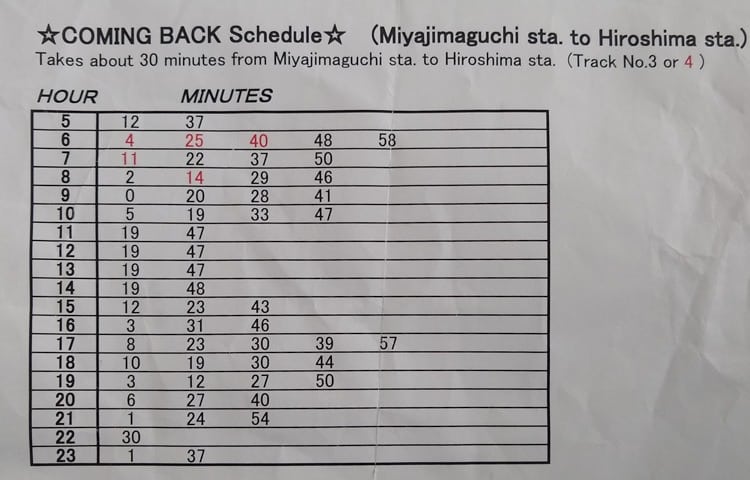
6:00 pm or 6:10 pm – Dinner in Hiroshima
You can easily have dinner again at Ekie or another place inside the train station. That’s what I did.
According to Inside Kyoto blog, when locals eat around the station area, they go to one of the many restaurants inside the station. Although there are English menus, there’s often no English name outside of these restaurants, so my advice is to just choose one with lots of Japanese people inside. If anyone would know what’s good, they would know.
7:00ish pm (or later) – Take a train back to Kyot o or Osaka
As a solo traveler, I’d take the 7:22 pm train getting into Kyoto at 9:20 pm. Then I could catch the bus back to my hotel.
If I were traveling with someone else, I’d perhaps stay late later and see the torii gate at night or the Atomic-Bomb Dome at night.
In Kyoto buses usually stop running at 11:00 pm and the subway at 11:30 pm.
Here was the train schedule from Hiroshima to Kyoto on January 17, 2019 :
- 7:17 pm –8:54 pm – direct – Nozomi line (no JR pass)
- 7:22 pm – 9: 20 pm – indirect through Osaka – Sakura line (JR pass)
- 8:01 pm – 10:36 pm – direct – Nozomi line (no JR pass)
- 8:52 pm – 11:09 pm – indirect through Osaka – Sakura line (JR pass)
- 9:03 pm – 10:45 pm – direct – Nozomi line (no JR pass)
- 9:58 pm – 12:09 am – indirect through Osaka – Hiraki line (JR Pass)
⇒ Check Hyperdia for train times for your date of travel.
Where to find more information
- Hiroshima Official Tourism Website
- Miyajima Official Tourism Website
- Train schedules – Hyperdia
- Restaurants at Hiroshima Train Station
- JR West Miyajima Ferry
- Hiroshima Peace Memorial Museum
- Embracing Defeat , by John Dower
- Hiroshima , by John Hershey
- Downfall , by Richard Frank
Final Thoughts: Hiroshima & Miyajima Itinerary
I came to Hiroshima with a burning question: was it necessary to drop a nuclear bomb on Nagasaki and Hiroshima? I had originally said, “no.” But I wanted to see what Hiroshima had to say. Seeing the Atomic Bomb Dome and hearing the survivors’ stories moved me deeply.
However, after touring all of the exhibits at the Peace Museum, I felt disappointed and a bit annoyed at the Hiroshima Peace Museum. Thus, I became less certain about my initial feelings that the bomb was wrong. But I didn’t know enough about the history of World War II in Asia to really answer this question.
Since that visit, I’ve read a number of books on the decision to bomb the two cities and the aftermath of the bomb. I’ve also read some books on what happened in Southeast Asia. The visit and my research have finally given me an answer to this burning question.
One of the things that bothered me in the museum was what they said about why the United States dropped the bomb. They mention only one reason: to prevent the Soviet Union from entering the war. In other words, the museum infers that the reason was purely political. No other reason was mentioned.
However, this is simply not true at all. The main reason why the United States dropped the atomic bomb was that the alternative would have been a land invasion, and this would have resulted in more lives being lost, a longer drawn-out war, and a more uncertain outcome.
Another reason is that Japan showed no intention of surrendering unconditionally any time soon even though at that point in the war, they were losing. Instead, they were trying to give themselves a better bargaining position when the time would come to negotiate for peace.
The United States had originally planned to invade Japan in November 1945. Through the codebreaking of Japanese communications, the U.S. found out that Japan was preparing to defend against the invasion with 900,000 soldiers and thousands of planes ready to conduct suicide attacks. It was estimated that total losses from trying to conquer Japan by land would have been 5 to 10 million Japanese deaths and 400,000 to 800,000 American deaths (Frank, page 340).
Not only that, it has been estimated that in 1945, 100,000 to over 250,000 Asian non-military people were dying each month from the Japanese occupation of their country. To carry the war into another year would have resulted in over a million more Chinese, Korean, and other Asian people dying.
This doesn’t even include the deaths of POWs who Japan notoriously mistreated (35% of POWs under the Japanese died while less than 1% of the POWs died under the Germans!)
Few people are aware of the experiments Japanese scientists were conducting in northeastern China, Burma, Thailand, and Singapore on the effects of biological weapons on thousands of men, women, children, and infants. Sadly, after the war, instead of charging these same scientists with war crimes, the U.S. hired them to continue testing biological weapons.
Another little known bit of history that many don’t know about is that the Soviet Union did invade Manchuria in the summer of 1945. According to Frank, the Soviet Union captured about 2.7 million Japanese, only one-third of whom were actual soldiers. Most were sent to labor camps in Russia. 347,000 to 376,000 of those captured died! And it took years (the 1950s and even into the 1990s) for those who did live to actually be allowed to return to Japan. There’s an interesting article from the New York Times about a Japanese man who was not allowed to return until 1998 . How insane is that!
I do want to add that it is debatable that the war would have even lasted long enough to reach those numbers since any large losses on the American part would have resulted in the American public turning against continuing the war and instead, demanding Truman sue for peace. The Japanese would not have needed to surrender unconditionally and would have likely been able to keep the same fascist military government in power with the same racist ideology.
Would ending the war without unconditional surrender have been fair to the 10 to 20 million Chinese who had died during the war?
Or the comfort women who were forced into becoming sex slaves for the Japanese military?
Or those who died from being given deadly diseases or operated on in Japanese scientific experiments?
Nuclear weapons are wrong and should never be used, ever, for any reason whatsoever. The nuclear weapons that exist now are much more powerful than the two used on Japan. We know what one less powerful bomb can do to a large city, which is something we didn’t know before. In fact, the United States had originally estimated that 20,000 people would die from the bomb. They were wrong. Between 100,000 and 200,000 people did actually die.
I commend the Hiroshima Peace Museum for promoting peace and for striving to eliminate all nuclear weapons. I think we need to be aware of the terrible and inhumane consequences of using nuclear weapons.
However, I think the Hiroshima Peace Museum is forgetting something even more important: we need to be aware and reminded of the terrible consequences of war in general and not just of atomic weapons. Atomic or nuclear weapons are just tools. Even if they are not used ever again, other tools or devices can be used with just as devastating of consequences.
If the Hiroshima Peace Museum was really a museum about “peace,” then they should look more closely at why wars start in the first place. The atomic bomb was bad, horrible, awful, but what the Japanese did to the people of Asia, POWs and its own people, what the Soviet Union did to Japanese POWs, and what the Americans did when firebombing Japanese cities were also just as awful if not more so.
If we cover up the past and fail to teach our children the truth, are we doomed to repeat history? Will we see another world war in our lifetime? 70 to 80 million people died as a result of World War II. That was 3% of the world’s population. Mechanisms like the United States, the EU, NATO, the WTO, and other international organizations were put in place after the war to prevent nations to solve problems through diplomacy rather than war. However, in the past two years, these organizations are slowly being weakened by certain countries and certain people.
Countries are notorious for blaming others for their problems. But when the leader of a country blames the loudest, then these feelings of victimhood become stronger, more widespread, and more vocal throughout the population. Germany and Japan went through this victimhood in the 1920s and 30s. Germany beget Hitler and Japan the military.
If you’ve got any questions about your own trip to Hiroshima and Miyajima, I’d be more than happy to answer them. If you’ve already been there and you have a comment, correction, or question, please leave in the comment section below! And if you’ve found this article useful, please share on social media! Thank you!
Best Resources for Your Trip to Japan
Book your flights for japan.
Use Skyscanner to find the cheapest flights to Japan. They will turn up results for all airlines including major ones and local airlines. You’re going to find EVERYTHING that’s available and thus get the cheapest price.
Book Your Accommodations for Japan:
The best hotel booking sites for Japan are Booking.com and Agoda . They have the biggest selection, and they consistently churn out hotels and hostels at the lowest prices of any other booking site. Another website for backpackers and budget travelers is Hostel World .
Book Your Tours for Japan:
The three best tour booking sites for Japan are Viator , Get Your Guide , and Klook . Viator has the biggest selection. Get Your Guide has terrific customer service. Klook specializes in tours in Asia.
Get Connected when in Japan:
You’ve got 3 options for staying connected in Japan: a pocket WiFi (what I used), a physical SIM card , or an eSIM . Several companies offer eSIMs for Japan. I recommend getting one through Klook or Airalo .
Book your Japan Rail Passes:
Japan has many different types of passes. The JR Pass is one of the most popular passes. Buy them through Klook before your trip to Japan. There are other passes as well like the Hakone Freepass .
Get Your Rail Pass for Tokyo
Get an unlimited train pass for most metro lines in Tokyo. They’re good for 1, 2, or 3 days. I always get the 3-day pass.
Are you on Pinterest?
Hey! How about saving one of these pins to Pinterest to read for later?
And feel free to follow me on Pinterest, where you'll find lots of travel articles for everywhere around the world.

Looking for more on Japan? Check out these posts:
- Japan Itinerary: The Perfect 3 Weeks in Japan
- Tokyo Itinerary: How to Spend 4 Perfect Days in Tokyo
- Hakone Itinerary: How to Spend 2 Days in Hakone
- Kyoto Itinerary 4 Weeks: A City of a Million Temples
- Nara Itinerary: The Perfect Day Trip from Kyoto
- Matsumoto Itinerary: Exploring Japan's Coolest Castle
- Shirakawago Itinerary: Enter a Japanese Fairytale
- Kamikochi Hiking: The Perfect Day Trip from Takayama
- Takayama Itinerary: Travel Back in Time to Old Japan
- The Best Ever Guide to Japan's Tateyama Kurobe Alpine Route
- Top 10 Must-See Places to Visit in Kyoto
- 13 Things You Need to Know Before Going to Japan
- The 20 Best Novels to Read Before Visiting Japan
Hi, Thank you for this informative blog 🙂 I was thinking would it be possible to do this itinerary. We are coming from Osaka and plan to take the first train in the morning going to Hiroshima, then go to Miyajima first?
Osaka -> Miyajima -> Hiroshima -> Osaka (1 day tour? is it enough?)
Also I got confused on how to get to Miyajima, there are 3 ways but which would be the fastest way? 🙂 Thank You
Thank you! I’m glad that you found it informative!
Doing Miyajima first and Hiroshima second would definitely work.
The JR train + JR ferry would get you there fastest because when you arrive in the morning by train from Osaka, you can just hop on another JR train to Miyajima (30 minutes). Then walk to the ferry terminal (5 minutes) and get on a JR ferry to Miyajima (10 minutes). The train leaves pretty frequently.
The second fastest way would be the World Heritage Ferry that leaves from the Peace Park. That would mean taking a streetcar from the train station to the Atomic Bomb Dome (20 minutes) – walking to the ferry (perhaps 5-10 minutes) – taking the World Heritage ferry to Miyajima (45 minutes). The World Heritage Ferry leaves every 30 minutes.
I made changes to the post to make it clearer.
I wanted to commend you for final thoughts on this article. When you posed your initial questions, I thought of how quickly tourists tend to demonize one side over another when they visit monuments/museums like these.
I was not expecting you to research the Japanese involvement prior to and during WWII but I’m glad you did! I agree whole-heartedly with your views on nuclear weapons and hope more people understand holistically the true costs of war. The war crimes committed by the Japanese truly devastated the people of China and S.E. Asia (like Singapore) and remain a significant part of their history. This is often overlooked, in my opinion, in Western understandings of the Asia-Pacific theater but is important to understand as it shapes the cultural and political stances of these countries today.
Thank you, Becca! Most people from Europe, North America, and Australia who visit the Peace Museum know next to nothing on what the Japanese did during the war. What they learn, they get from the Peace Museum, which is very one-sided. The museum talks only about the bomb and they’re not completely truthful when they do talk about it. I wish more people in the West knew about how the Japanese treated the Chinese, Koreans, and the people of SE Asia.
Submit a Comment Cancel reply
Your email address will not be published. Required fields are marked *
Submit Comment
This site uses Akismet to reduce spam. Learn how your comment data is processed .

Grab a FREE Japan Itinerary Guide
Get all my great travel tips as well as this FREE Japan travel and itinerary guide sent to your email right away!
You have Successfully Subscribed!
What are you looking for, about the bamboo traveler.

Welcome to The Bamboo Traveler, a travel blog dedicated to helping those travelers who want to dig deeply into the history, heritage, and culture of a place. Whether it’s through the pages of your passport or the pages of a book, I’ll help you travel the world and uncover the history, culture, food, architecture, and natural beauty of some of the world’s most fascinating places.
Follow the Bamboo Traveler

Traveling to Japan soon?
Posts about japan.
- Japan Itinerary : The Perfect 3 Weeks in Japan
- Tokyo Itinerary : How to Spend 4 Perfect Days in Tokyo
- Kanazawa Itinerary: 2 Days in the Cit of Samurais
- Kyoto Itinerary 4 Weeks : A City of a Million Temples
- Nara Itinerary : The Perfect Day Trip from Kyoto
- Kamikochi Hiking : The Perfect Day Trip from Takayama
- Takayama Itinerary : Travel Back in Time to Old Japan
- Top 10 Must-See Sites in Kyoto
- Traveling Solo in Japan: The Good, the Bad, and the Ugly
Table of Contents
- 5:00 pm – Leave MIyajima

Get Your FREE Japan Itinerary Guide Here!
Subscribe to my newsletter to receive the latest travel tips for Asia and get a free 4-page PDF version of my 3-Week Japan Itinerary.
Pin It on Pinterest
Kyoto Departure – 1 Day Hiroshima & Miyajima Tour
Embark on a journey that symbolizes the fusion of historical depth and natural splendor with the ‘Kyoto Departure – 1 Day Hiroshima & Miyajima Tour’.
This meticulously crafted itinerary promises travelers a day filled with enriching experiences and profound insights into Japan’s cultural tapestry. From the iconic landmarks of Hiroshima to the serene beauty of Miyajima, each moment unfolds a different facet of the country’s heritage.
The tour’s commitment to delivering transformative travel experiences resonates throughout, setting the stage for an unforgettable exploration.
Curious to uncover more about this immersive excursion?
Key Takeaways
- Tour feedback highlights desire for more time in Hiroshima than Miyajima.
- Visitors suggest enhancing guide communication and time management .
- Some dissatisfaction with short duration at the Peace Memorial Park.
- Balancing time allocation between Miyajima and Hiroshima is crucial for tour improvement.
Here's some more nearby activities we've reviewed
- Kyoto: Morning Japanese Bento Cooking Class
- Kyoto: Nishiki Market Food Tour
- Kyoto: Private 2.5 Hour Historical Walking Tour
- Kyoto: Fushimi Inari Taisha Last Minute Guided Walking Tour
Tour Details
The Kyoto Departure – Hiroshima & Miyajima Tour offers a comprehensive experience with a professional English-speaking guide, covered admission fees , transportation costs , and the Miyajima visitor tax, along with convenient hotel pick-up and drop-off services.
The tour ensures a seamless communication experience for English speakers, with guides possessing high English proficiency levels. Visitors can expect clear and informative communication throughout the journey, enhancing their overall understanding and enjoyment of the destinations.
The focus on communication enhancement ensures that travelers can fully immerse themselves in the historical and cultural significance of Hiroshima and Miyajima. By having knowledgeable guides with strong English skills, participants can engage more deeply with the sights and stories presented, making the tour both educational and enriching.
Additional Information
Moving on from the tour details, travelers are advised that meal charges for lunch aren’t included in the Kyoto Departure – Hiroshima & Miyajima Tour package. When considering meal options , tourists can explore local eateries on Miyajima Island, savoring fresh seafood dishes like grilled oysters or trying Momiji Manju, a maple leaf-shaped cake filled with various flavors.
While accessibility accommodations aren’t available on this tour, visitors can enjoy the scenic beauty and cultural experiences at their own pace. It’s recommended to carry snacks or light meals for convenience during the journey. For those with specific dietary requirements or preferences, bringing along suitable snacks ensures a comfortable and enjoyable exploration of Hiroshima and Miyajima.
Feedback and Reviews
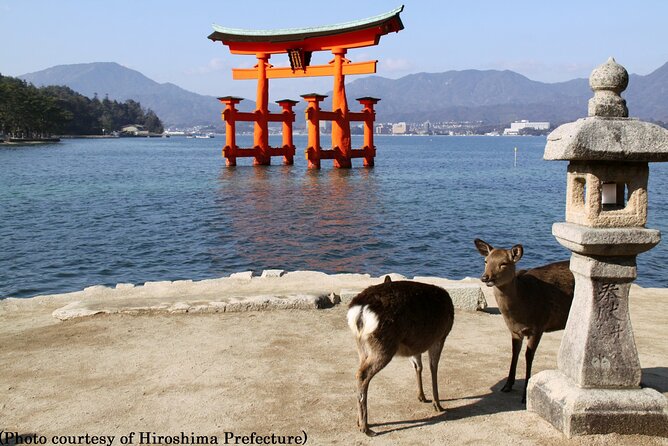
Receiving varied feedback from visitors, the Kyoto Departure – Hiroshima & Miyajima Tour showcases a mix of positive and constructive comments on guide performance and overall experience. Visitors appreciated the historical insights provided by guides and their professionalism. However, there were mixed reviews on the guides’ English proficiency and communication skills.
Some visitors expressed dissatisfaction with the short time allocated at the memorial park and raised concerns about group size and crowd control . Suggestions for improvement included enhancing communication, particularly in English , and better tour organization for crowd control .
Time Allocation
Visitors have expressed a desire for more time in Hiroshima compared to Miyajima during the Kyoto Departure – Hiroshima & Miyajima Tour. To address this feedback and enhance the overall experience, consider the following :
Sightseeing priorities:
- Allocate additional time at the Hiroshima Peace Memorial Museum for a more in-depth exploration of the exhibits and historical significance.
Itinerary adjustments:
- Consider revising the schedule to allow for more flexibility and extended stays at key locations like the Peace Memorial Park.
Balancing time:
- Strive to find a better balance between the time spent in Miyajima and Hiroshima, ensuring that visitors have ample opportunities to appreciate both destinations without feeling rushed.
Guide Performance
How effectively does the guide engage with and inform tour participants during the Kyoto Departure – Hiroshima & Miyajima Tour?
The guide on this tour has received positive feedback for attentiveness and sharing valuable information, particularly during the emotional visit to the Peace Memorial Museum. However, there have been mixed reviews regarding the guide’s English proficiency and communication skills. Some participants have suggested enhancements in these areas to improve the overall tour experience.
Strengthening English proficiency can ensure clearer explanations and better interactions with a diverse group of travelers. Enhancing communication skills could lead to a more engaging and informative tour, helping participants fully appreciate the historical and cultural significance of the destinations visited. Feedback suggests that focusing on communication enhancement would greatly benefit the guide’s performance on this tour.
Itinerary Highlights
The itinerary highlights of the Kyoto Departure – Hiroshima & Miyajima Tour include a bullet train journey to Hiroshima, a visit to Miyajimaguchi, lunch on Miyajima Island, and exploration of the Hiroshima Peace Memorial Park.
Historical Landmarks :
- Witness the resilience of Hiroshima at the Peace Memorial Park.
- Explore the iconic UNESCO World Heritage Site, Miyajima Island.
- Learn about the rich history of the region at Miyajimaguchi.
Cultural Experiences :
- Immerse yourself in the cultural significance of Miyajima’s floating torii gate.
- Enjoy a traditional Japanese lunch on the picturesque Miyajima Island.
- Reflect on the profound impact of the Hiroshima Peace Memorial Park.
This tour promises a day filled with historical insights and profound cultural experiences at these renowned landmarks.
Departure and Return Details
For a seamless start to your Kyoto Departure – Hiroshima & Miyajima Tour experience, the meeting point is the JTB SUNRISE TOURS DESK KYOTO, where the adventure begins promptly at 07:40 AM.
Guests can choose from various transportation options , with the tour including a bullet train ride to Hiroshima. The day’s activities encompass a visit to Miyajimaguchi, a delightful lunch on Miyajima Island, and exploration of the poignant Hiroshima Peace Memorial Park.
The tour ensures a smooth return, with the endpoint at Kyoto Station around 9:00 PM. Participants can expect a well-rounded experience with transportation costs and admission fees covered, alongside the expertise of a professional English-speaking guide. Departure time is carefully coordinated to maximize the tour’s highlights and ensure a memorable day trip.
Suggestions for Improvement
To enhance the overall tour experience, consider implementing feedback to improve communication and time management for a more seamless and enriching journey. Here are three suggestions for improvement:
Enhance Communication : Implement regular updates and clear instructions throughout the tour to keep participants informed about the schedule and any changes.
Optimize Time Management : Consider adjusting the itinerary to allow for more time at significant locations like the Peace Memorial Museum in Hiroshima, ensuring a more in-depth exploration.
Balance Between Locations : Strive to find a better balance between the time spent at Miyajima and Hiroshima, catering to varying interests and ensuring a comprehensive experience for all participants.
Here's a few more nearby tours and experiences we have reviewed.
- Kyoto: Full-Day Best UNESCO and Historical Sites Bus Tour
- Kyoto: Gion Night Walking Tour
- Kyoto: All-Inclusive 3-Hour Food and Culture Tour in Gion
- Kyoto: Arashiyama Bamboo Forest Morning Tour by Bike
- Kyoto: Private Tour With Local Licensed Guide
- Kyoto: 3-Hour Fushimi Inari Shrine Hidden Hiking Tour
Frequently Asked Questions
Can i bring my own lunch for the tour instead of purchasing one on miyajima.
Yes, visitors can bring their own lunch for the tour if they have dietary restrictions or prefer homemade meals. It’s advisable to inform the tour provider in advance about any special dietary needs for a smooth experience.
Is There a Specific Dress Code or Attire Recommended for Visiting the Hiroshima Peace Memorial Park?
When visiting Hiroshima Peace Memorial Park, it’s essential to dress respectfully. Appropriate attire includes modest clothing out of cultural sensitivity . Opt for comfortable yet respectful outfits, such as covering shoulders and knees. This shows reverence for the historical significance of the site.
Are There Any Optional Activities or Attractions That Can Be Added to the Itinerary?
For those seeking extra experiences, the tour offers customization options like optional activities and attractions. Visitors can enhance their journey by adding personalized elements to the itinerary, providing flexibility and a tailored adventure.
Can I Visit the Itsukushima Shrine on Miyajima During the Tour, or Is It Only a Lunch Stop?
Visitors can explore Itsukushima Shrine during the tour, but time constraints may limit the visit. The tour schedule includes lunch on Miyajima, offering a chance to see the shrine. However, balancing time between attractions is important due to the itinerary.
Is There a Specific Souvenir Shop Recommended for Purchasing Memorabilia Related to Hiroshima and Miyajima During the Tour?
For those seeking local crafts and authentic memorabilia, artisan workshops in Hiroshima and Miyajima offer unique souvenirs. Visitors can explore these shops during the tour to find meaningful keepsakes reflecting the rich culture of the region.
Here's more of our most recent tour reviews happening neaby
- Full-Day Private Bamboo Grove and Golden Temple in Kyoto Tour
- Cherry Blossom Family Picnic
- Kyoto & Nara Day Tour From Osaka/Kyoto: Fushimi Inari, Arashiyama
- Kyoto Sweets and Green Tea Making and Town Walk.
- Samurai Sword Experience in Kyoto (Family & Kid Friendly)
- Living Buddhism
- Private Kyoto Tour With Hotel Pick up and Drop off
- Simple Kimono Plan&Gorgeous Kimono Experience
- Kyoto Culture With the Expert: Kimono, Zen, Sake (Wednesdays and Saturdays)
- Sake Tasting in Central Kyoto
- [To Kyoto・Kiyomizu Temple] 3 Minutes on Foot, Yukata (Kimono) Plan. You Can Explore Sightseeing Spots and the Townscape All Day (Return by 5 P.M.)
Embark on the Kyoto Departure – 1 Day Hiroshima & Miyajima Tour for a transformative journey through Japan’s rich history and breathtaking beauty. With a professional guide, seamless transportation , and poignant stops at iconic landmarks, every moment is filled with cultural significance.
While feedback suggests areas for improvement, the commitment to delivering an unforgettable travel experience remains strong. Explore the essence of Japan and create lasting memories on this immersive excursion.
Similar Posts
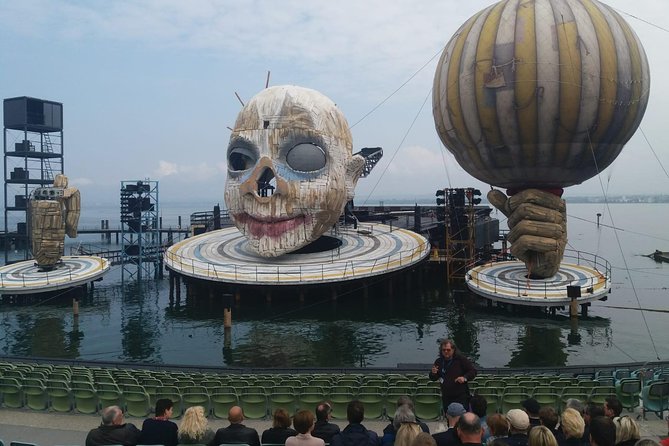
Guided Bike Tour Lake Constance Cycle Path Incl Bregenz Stage & Pfänder Mountain
Set out on an unforgettable journey through one of Europe’s most stunning cycling routes with the guided bike tour of…
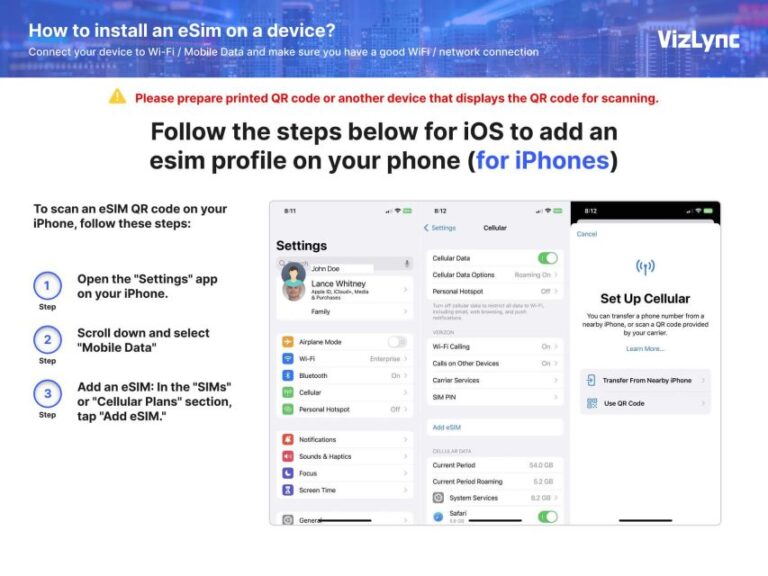
Explore Europe With 10GB High-Speed Premium Esim Data Plan
Travelers to Europe often face the challenge of staying connected while exploring various countries. Imagine having 10GB of high-speed premium…
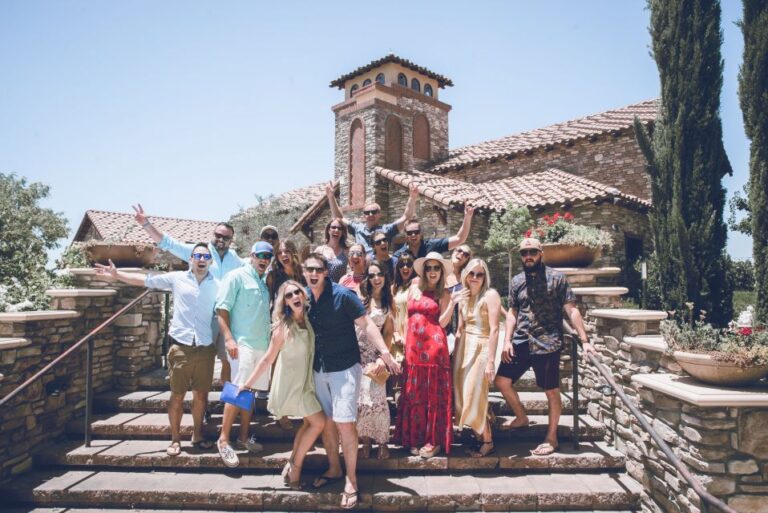
Temecula: All-Inclusive Wine Tasting Tour With Lunch
Envision a day filled with the clinking of glasses and the aroma of oak barrels, as the Temecula Valley beckons…

Surf Lesson
In the realm of surfing, a wave is like a blank canvas awaiting the stroke of a master’s brush. As…
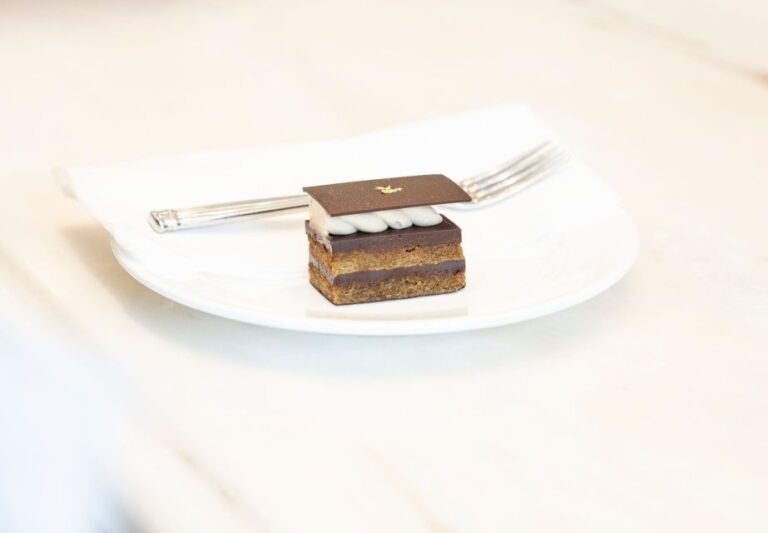
Charleston: Savor the Flavors Upper King Street Food Tour
Stroll along the bustling streets of Upper King Street in Charleston, where the tantalizing aromas of Southern cuisine waft through…
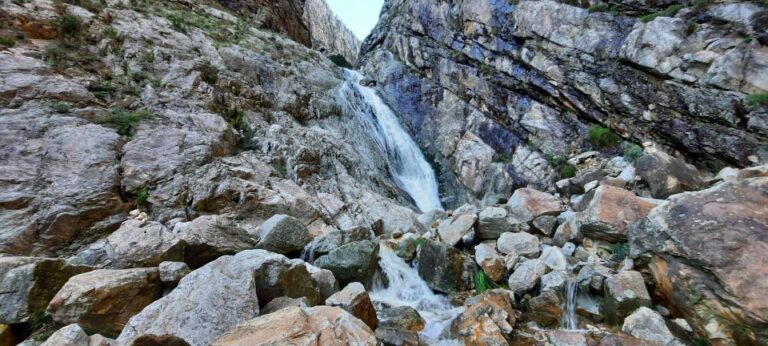
Devil’s Gorge Hike
As hikers venture into the depths of Devil’s Gorge, they are met with a profound sense of mystery and intrigue,…
- Kyoto & Nara
- Kanazawa & Takayama
- 7 Days or less
- 14 Days or More
- 7 Days or Less
- Independent 3 Day Packages
- Independent 5 Day Packages
- Independent Ducati Packages
- Barrier Free
- Book Japan Rail Pass
- JR East Pass
- JR West Pass
- JR Hokkaido Pass
- JR Central Pass
- JR Kyushu Pass
- JR Shikoku Pass
- Journey Planning
- Seat Reservation Information
- Baggage Information
- Rail Pass FAQ
- Okinawa Unique Stays
- Okinawa Ocean Adventures
- Okinawa Jungle Adventures
- Okinawa Tradition & Culture
- Okinawan Cuisine
- The Ryukyu Kingdom: A Brief History
- Island Life: Okinawan Culture and Traditions
- The Nature of Okinawa
- Local Specialities: Diet and Longevity in Okinawa
- Okinawa Hontō (Okinawa Main Island)
- Okinawa Shoto (Kerama Islands)
- Miyako Retto (Miyako Island)
- Yaeyama Retto (Yaeyama Islands)
- Driving in Okinawa
- Fukushima Activities & Family Fun
- Diamond Route Japan
- Fukushima Food
- Fukushima Onsen Experiences
- Fukushima Unique Stays
- Driving in Fukushima
- Spectacular Snow
- Visa Assistance
- Our Branches
- Agent Login

- Hiroshima and Miyajima 1 Day Tour
Hiroshima & Miyajima 1-Day Tour
From $286 aud.
https://www.traveljapan.com.au/booking-conditions
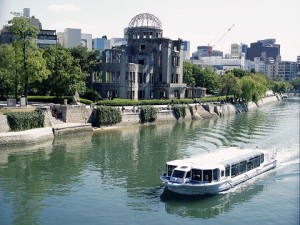
Visit three UNESCO World Heritage sites. Miyajima is famous for its Itsukushima-jinja Shrine. Its red Torii gate appears to be standing in the sea during high tide. Walk through the Hiroshima Peace Memorial Park, dedicated to promoting peace around the world and visit the Atomic Bomb Dome, one of the only surviving structures after the explosion.
Day 1 Hiroshima - Miyajima - Hiroshima (From Hiroshima Departure)
Day 1 kyoto - hiroshima, miyajima - kyoto (from kyoto departure / from osaka departure).
- English speaking guide
- Transportation
- Pick-up service available for Kyoto/Osaka. Not available for Hiroshima. Assemble at Hotel Granvia Hiroshima at 10:30.
- Drop-off service available for Kyoto/Osaka. Not available for Hiroshima. Tour disbands upon arrival at Hiroshima station.
1.The tour will be accompanied by a certified English-speaking guide or an English-speaking tour assistant. from Kyoto and Osaka Departure, English-speaking guide or assistance services is included except while on board the Shinkansen. 2, Minimum participants required 2 persons. If the minimum number of participants is not met by 5 days before a scheduled date, the tour on that date may be cancelled. 3.According to the number of participants, transportation (microbus, raxi, train or tram) between Hiroshima and Miyajima will vary depending on the number of participants. 4.Lunch is not included in the tour. Please have lunch on your own at Miyajima.
Ready to explore?
« Back to Product Listings
More Japan Travel Packages
Best of hiroshima night food tour, hiroshima bar hopping food tour, sake town tour in saijo hiroshima.

IMAGES
VIDEO
COMMENTS
The Osaka Departure - 1 Day Hiroshima & Miyajima Tour is a captivating journey that takes travelers from bustling Osaka to historic Hiroshima and Miyajima Island. Participants will embark on a day filled with cultural and historical discoveries, starting with a transfer to Shin-Osaka station and a bullet train ride to Hiroshima. ...
See the historical highlights of Hiroshima on a comprehensive full-day tour from Osaka. Ride on the super-speed bullet train to Hiroshima then board a boat to the idyllic Miyajima Island, home to the splendid Itsukushima Shrine. Return to Hiroshima to feel emotionally stirred by the magnificent Hiroshima Peace Memorial Park and Museum, in which intriguing exhibitions speak eloquently of the ...
If you're planning to do this, you can either book a one day Hiroshima and Miyajima guided tour from Osaka, or follow our one-day itinerary for both places below: Instead of going all the way to Miyajimaguchi Station to board a boat, consider taking a ferry departing from Motoyasu Pier. You can purchase your tickets directly at the terminal ...
・Explore Hiroshima city with a Tour bus and a comfortable air-conditioned. ・Special Ferry route from Hiroshima to Miyajimaguchi. ・Take pictures of Great Torii from the nearest location on the ferry Join this full-day bus tour from Hiroshima Station, as we will visit some popular attractions. The first stop will be Itsukushima Shrine at Miyajima Island, which is famous for the historic ...
It is about a 30-minute ride from Hiroshima to Miyajimaguchi Station. Once you arrive at Miyajimaguchi Station, follow the signs for the Miyajima Island ferry. The ferry is no more than a 10-minute walk from the Miyajimaguchi Station. Both, the train and the ferry are covered by the JR Pass.
Our Hiroshima & Miyajima Day Tour is the perfect choice for those who choose to bear witness to both Hiroshima's heart-rending history and ancient serenity all in one day. This tour, which begins and ends in Hiroshima, is guided by a government-licensed expert who is passionate about sharing the city's story and ensuring its memories are ...
Hiroshima / Miyajima Full-day Private Tour with Government Licensed Guide. 542. 7 hours. Free Cancellation. From. $162.13. Likely to Sell Out. Miyajima Half-day Private Tour with Government Licensed Guide. 78. 4 hours. Free Cancellation. From. $92.64. Full Day Tour in Hiroshima and Miyajima. 1. 7 to 8 hours. Free Cancellation.
US$ 109.99. Select options. Explore Hiroshima city with a Tour bus comfortably air-conditioned. Lunch is Authentic Hiroshima-style Okonomiyaki which is topped with pork,cabbage, bean sprout, noodle, and an egg. (in stated as included in the plan) Special Ferry route from Hiroshima to Miyajima guchi.
Participants on the Hiroshima and Miyajima 1 Day Walking Tour can explore the top sights and must-see landmarks in both cities within a day. In Hiroshima, one of the key attractions is the Peace Memorial Park, which commemorates the victims of the atomic bomb and serves as a symbol of peace. Visitors can also visit the Hiroshima Peace Memorial ...
This tour is a must-book for history buffs and nature lovers. Book through Klook and get to visit the city of Hiroshima and the island of Miyajima in one day! Visit the Peace Memorial Park and Museum and learn about the tragedy and eventual recovery of Hiroshima. Ride a ferry to the Itsukushima Shrine in Miyajima, explore its sacred halls, and ...
Lunch break. Go to Miyajima by ferry. Bus to Peace Memorial Park and visit the Hiroshima Peace Memorial Museum. See the Atomic Bomb Dome. 21:00 - Return from Hiroshima Station back to Kyoto via Shinkansen bullet train. NB - all timings on Hiroshima & Miyajima Tour By Bullet Train from Kyoto are approximate.
The 'Hiroshima and Miyajima 1 Day Walking Tour' immerses travelers in the rich history and culture of Hiroshima and Miyajima, Japan. Led by knowledgeable local experts, participants explore historic sites and learn about their significance. The tour offers customization options and starts at 9:00 AM, providing ample time to visit highlights ...
Miyajima is a small island off the coast of Hiroshima and is regarded as the Island of the Gods. It is an eclectic mix of Buddhist temples and Shinto shrines and wild deer roam the streets. Miyajima is home to the revered Itsukushima Shrine and its iconic floating tori gate. Miyajima/Hiroshima itinerary tip: we recommend starting the day in ...
The tour starts at 07:50 AM and ends at Osaka Station around 9:00 PM. The tour includes a visit to Miyajimaguchi and Miyajima Island, where participants can explore the Itsukushima Shrine and its Treasure Hall. Participants will also have the opportunity to reflect at the Hiroshima Peace Memorial Park and visit the Hiroshima Peace Memorial Museum.
Hiroshima Departure - 1 Day Hiroshima & Miyajima Tour. By JTB Sunrise Tours. 40 reviews. See all photos. About. from. $142.97. per adult. Lowest price guarantee Reserve now & pay later Free cancellation.
World Heritage Sea Route Ferry from the Peace Park. There is also a direct ferry to Miyajima from Hiroshima Peace Park called the Hiroshima World Heritage Sea Route. It costs ¥2,000 (US$18.37/€16/£14.42) one way and ¥3,600 (US$33 /€29/£26) round-trip. It takes 45 minutes and leaves every 30 minutes.
This day trip to Hiroshima and Miyajima is the easy way to see many sights in a single day, some of which are UNESCO World Heritage sites. Travel by comfortable air-conditioned coach to important World War II-era places in Hiroshima, and the iconic red gates of Miyajima's Itsukushima Shrine, which appear to float on water. Learn all about the history and culture of these attractions from ...
Osaka to Hiroshima by Bus. A much longer journey, you can take the daytime or overnight buses from Osaka to Hiroshima. It will take about 5 hours and costs between 2,000 and 13,500 yen. Another great budget friendly option for a one day trip to Hiroshima and Miyajima.
Embark on a journey that symbolizes the fusion of historical depth and natural splendor with the 'Kyoto Departure - 1 Day Hiroshima & Miyajima Tour'. This meticulously crafted itinerary promises travelers a day filled with enriching experiences and profound insights into Japan's cultural tapestry. From the iconic landmarks of Hiroshima ...
If the minimum number of participants is not met by 5 days before a scheduled date, the tour on that date may be cancelled. 3.According to the number of participants, transportation (microbus, raxi, train or tram) between Hiroshima and Miyajima will vary depending on the number of participants. 4.Lunch is not included in the tour.
Visit Hiroshima Peace Memorial Park and the A-Bomb Dome on a 1-day bus trip. Cross the sea on a ferry to Miyajima Island to see the famous UNESCO World Heritage Site, Itsukushima Shinto Shrine.
586 reviews. 353 helpful votes. Miyajima a day trip report. Apr 20, 2024, 7:32 AM. Aloha. I'm based in Hiroshima for one more day. My final excursion is to Miyajima which I took today as a day trip. It was super easy to do , and extremely affordable. From Hiroshima's main station I clicked my way via my IC Carson my wallet and headed down ...
Explore the highlights of Hiroshima and Miyajima the easy way on a private full-day tour with a guide. You'll learn all about Hiroshima's dark history and prosperous present at sites like the Peace Park and A-Bomb Dome. Travel by public transport (as the locals do) to nearby Miyajima Island, a naturally and culturally beautiful spot with its own fascinating history. The tour can be ...
tram: ¥240. train to Saijo: ¥590 each way. private vehicle option: By private vehicle: 2- 4 passengers: ¥13000. 5-6 passengers: ¥18000. 7-9 passengers ¥27,000. costs reimbursed directly to me on the day in JPY in cash. ENTRIES.
10 likes, 0 comments - grandtour_musubi_jpApril 9, 2024 on : "Day 4 #miyajima & #hiroshima #bentleyrisingsunrally2024".